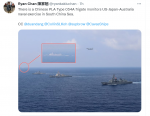You are using an out of date browser. It may not display this or other websites correctly.
You should upgrade or use an alternative browser.
You should upgrade or use an alternative browser.
ALERT The Winds of War Blow in Korea and The Far East
- Thread starter northern watch
- Start date
Zagdid
Veteran Member
PLA Navy's 2nd Sovremenny-class destroyer returns after upgrades
By Liu Xuanzun Published: Mar 17, 2022 01:38 AM
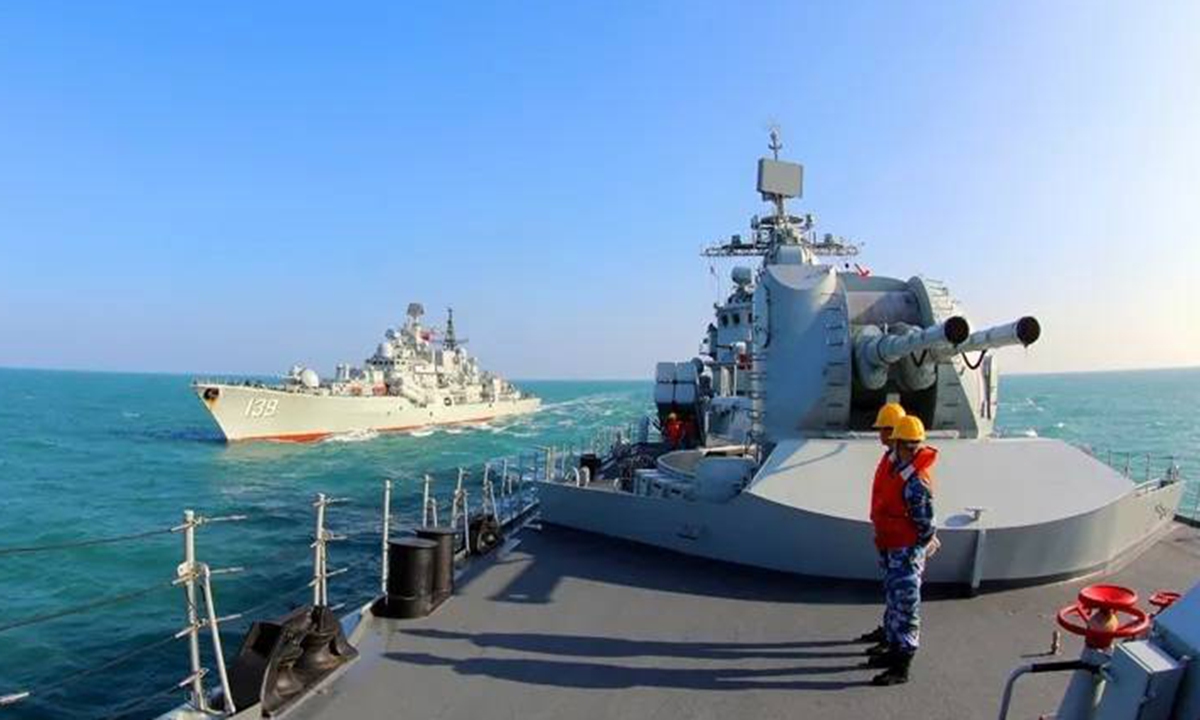
Sovremenny-class guided missile destroyer Hangzhou (Hull 136) and Ningbo (Hull 139) attached to the PLA Eastern Theater Command Navy conduct exercises in early 2021. Photo: Screenshot from navy.81.cn
The Fuzhou, the second Sovremenny-class destroyer and one of the last imported vessels of the Chinese People's Liberation Army (PLA) Navy, has recently returned to active service and joined exercises after undergoing a refit and modernization, with experts saying on Wednesday that the warship is now even more powerful and adapted to the PLA Navy's combat system.
Distinguishable by its hull number 137, the Fuzhou featured in a series of drills recently organized by the PLA Eastern Theater Command, eastday.com, a Shanghai-based online news outlet, reported on Tuesday, citing a recent press release by the PLA Eastern Theater Command and a recent report by China Central Television.
This indicates that the Fuzhou has wrapped up its mid-term upgrade and refit and has returned to active service, eastday.com reported.
Just like the Hangzhou, the PLA Navy's first Sovremenny-class destroyer that finished its refitting in late 2019 and was seen taking part in exercises in March 2021, the Fuzhou now has a 32-unit vertical launch missile system for the HHQ-16 air defense missiles that replaced the two original sets of Shtil air defense missile systems, and eight YJ-12 supersonic anti-ship missiles that replaced the original eight P-270 anti-ship missiles, the report said.
The modification of the vessel means all of its missiles are now domestically developed, Wei Dongxu, a Beijing-based military expert, told the Global Times on Wednesday.
The HHQ-16 is a type of mid-to-close-range air defense missile that can establish a dense anti-aircraft and anti-missile umbrella, and the YJ-12 can provide stronger long-range anti-ship firepower, Wei said, noting that with the modernization, the Sovremenny-class destroyer has become comprehensively stronger in both defensive and offensive capabilities.
In addition to the new weapons, the Fuzhou also upgraded its electronic systems, eastday.com said.
This could be seen in the destroyer's radar, electronic warfare, communications and command, and control systems, Wei said, noting that this will allow the warship to better coordinate with other advanced PLA vessels.
China acquired two (Russian) Sovremenny-class destroyers of the 956E variation, the Hangzhou in 1999 and the Fuzhou in 2000, and other two Sovremenny-class destroyers of the improved 956EM variation, the Taizhou in 2005 and the Ningbo in 2006, eastday.com reported.
All the 956E ships have been upgraded and the two 956EM are also expected to be modified and refitted, the report said.
jward
passin' thru
Xi says improper handling of Taiwan issues will hit China-U.S. ties
Reuters
2 minute read

Chinese President Xi Jinping arrives for the closing session of the Chinese People's Political Consultative Conference (CPPCC) at the Great Hall of the People in Beijing, China March 10, 2022. REUTERS/Carlos Garcia Rawlins
Register now for FREE unlimited access to Reuters.com
BEIJING, March 19 (Reuters) - Chinese President Xi Jinping told his U.S. counterpart Joe Biden on Friday that the Taiwan issue needs to be handled properly to avoid a negative impact on Sino-U.S. relations, according to Chinese media.
China says Taiwan, which it views as a breakaway province to be brought back to the fold, by force if necessary, is the most sensitive and important issue in its relations with the United States.
/cloudfront-us-east-2.images.arcpublishing.com/reuters/RN5IHFMIP5KJHLRBA52VCH4RBQ.jpg)
 www.reuters.com
Washington, which is seeking Beijing's help in restoring peace in Ukraine after Russia's Feb. 24 invasion, has no formal diplomatic ties with Taipei, but is Taiwan's most important international backer and arms supplier.
www.reuters.com
Washington, which is seeking Beijing's help in restoring peace in Ukraine after Russia's Feb. 24 invasion, has no formal diplomatic ties with Taipei, but is Taiwan's most important international backer and arms supplier.
"Some individuals in the United States are sending the wrong signals to pro-independence forces in Taiwan, and that's very dangerous," Xi told Biden on a video call.
"If the Taiwan issue is not handled properly, it will have a subversive impact on the relationship between the two countries."
China sailed its aircraft carrier Shandong through the Taiwan Strait, shadowed by a U.S. destroyer, on Friday, a source with direct knowledge of the matter told Reuters, just hours before the Chinese and U.S. presidents were due to talk. read more
China has over the past two years stepped up its military activity near the island to assert its sovereignty claims.
"(We) hope the U.S. side will pay adequate attention (to the issue)," Xi told Biden.
Xi also told Biden that the war in Ukraine must end as soon as possible, according to Chinese state media.
All parties should jointly support the Russia-Ukraine dialogue while the United States and NATO should also conduct talks with Russia to solve the "crux" of the Ukraine crisis, Xi said. read more
Reuters
2 minute read

Chinese President Xi Jinping arrives for the closing session of the Chinese People's Political Consultative Conference (CPPCC) at the Great Hall of the People in Beijing, China March 10, 2022. REUTERS/Carlos Garcia Rawlins
Register now for FREE unlimited access to Reuters.com
BEIJING, March 19 (Reuters) - Chinese President Xi Jinping told his U.S. counterpart Joe Biden on Friday that the Taiwan issue needs to be handled properly to avoid a negative impact on Sino-U.S. relations, according to Chinese media.
China says Taiwan, which it views as a breakaway province to be brought back to the fold, by force if necessary, is the most sensitive and important issue in its relations with the United States.
/cloudfront-us-east-2.images.arcpublishing.com/reuters/RN5IHFMIP5KJHLRBA52VCH4RBQ.jpg)
Xi says improper handling of Taiwan issues will hit China-U.S. ties
Chinese President Xi Jinping told his U.S. counterpart Joe Biden on Friday that the Taiwan issue needs to be handled properly to avoid a negative impact on Sino-U.S. relations, according to Chinese media.
"Some individuals in the United States are sending the wrong signals to pro-independence forces in Taiwan, and that's very dangerous," Xi told Biden on a video call.
"If the Taiwan issue is not handled properly, it will have a subversive impact on the relationship between the two countries."
China sailed its aircraft carrier Shandong through the Taiwan Strait, shadowed by a U.S. destroyer, on Friday, a source with direct knowledge of the matter told Reuters, just hours before the Chinese and U.S. presidents were due to talk. read more
China has over the past two years stepped up its military activity near the island to assert its sovereignty claims.
"(We) hope the U.S. side will pay adequate attention (to the issue)," Xi told Biden.
Xi also told Biden that the war in Ukraine must end as soon as possible, according to Chinese state media.
All parties should jointly support the Russia-Ukraine dialogue while the United States and NATO should also conduct talks with Russia to solve the "crux" of the Ukraine crisis, Xi said. read more
jward
passin' thru
Breaking911
@Breaking911
3h
JUST IN: White House readout on Biden's call with Chinese President Xi Jinping: "[Pres. Biden] described the implications and consequences if China provides material support to Russia."
@Breaking911
3h
JUST IN: White House readout on Biden's call with Chinese President Xi Jinping: "[Pres. Biden] described the implications and consequences if China provides material support to Russia."
jward
passin' thru
Xi says against war in talk with Biden on Ukraine
AFP
March 18, 2022 9 hours ago
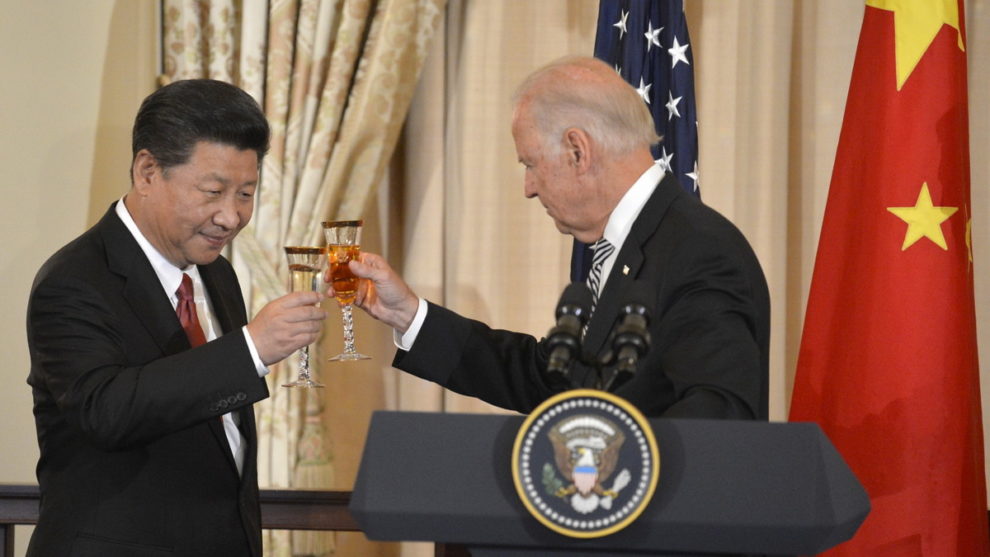
Chinese leader Xi Jinping said war is “in no one’s interest” during a phone call Friday with President Joe Biden, but he showed no sign of giving in to US pressure to join Western condemnation of Russia’s invasion of Ukraine.
State broadcaster CCTV reported that Xi said during the call that “state-to-state relations cannot go to the stage of military hostilities.”
And in a longer readout published by the Chinese foreign ministry, Xi said “all sides” need to support “dialogue” between Russia and Ukraine.
He also appeared to put some responsibility for Russia’s invasion of its neighbor on the West, saying “the US and NATO should also have dialogue with Russia to address the crux of the Ukraine crisis and ease security concerns of both Russia and Ukraine,” the foreign ministry noted.
The phone call, which lasted one hour and 50 minutes, ended at 10:53 am in Washington (1453 GMT), the White House said.
Three hours later, the US side had not yet published its account of the call, in which Biden hoped at minimum to persuade Xi to give up any idea of countering Western sanctions and bailing out Russian President Vladimir Putin’s government.
China should “understand that their future is with the United States, with Europe, with other developed and developing countries around the world. Their future is not to stand with Vladimir Putin,” Deputy Secretary of State Wendy Sherman told CNN earlier Friday.
Beijing has consistently refused to condemn its fellow authoritarian ally and Washington fears China could now deliver financial and military support for Russia, transforming an already explosive transatlantic standoff into a global dispute.
If that happened, not only could Beijing help Putin to weather sanctions and continue his war, but Western governments would face the painful decision of how to strike back at the world’s second-biggest economy, likely prompting turmoil on international markets.
The White House was tight-lipped on whether Biden would threaten China with economic sanctions during his call, but some sort of response was on the table.
Biden “will make clear that China will bear responsibility for any actions it takes to support Russia’s aggression and we will not hesitate to impose costs,” Secretary of State Antony Blinken said ahead of the call.
Blinken urged China to use its “leverage” on Moscow.
– China ‘balancing competing priorities’ –
The Biden-Xi call came after US National Security Advisor Jake Sullivan and Yang Jiechi, the Chinese Communist Party’s chief diplomat, held what the White House called a “substantial” seven-hour meeting in Rome this week.
Against a backdrop of already intense US-Chinese tensions over Taiwan and trade disputes, the ability or failure of Biden and Xi to come to an understanding on the unfolding mayhem in Europe will reverberate widely.
Xi and Putin symbolically sealed their close partnership when they met at the February Winter Olympics in Beijing — just before Putin launched his onslaught on Ukraine.
Since then, Beijing has stood out by refusing to join international outcry over the invasion, while taking the Russian line in blaming the United States and NATO for European tensions.
Chinese authorities even refuse to refer to the invasion as a “war,” again in keeping with Kremlin talking points.
But China has also tried to remain somewhat ambiguous, declaring support for Ukraine’s sovereignty.
Brookings Institution fellow Ryan Hass, a former advisor on China to president Barack Obama, said Beijing has to sort through its clashing priorities.
Despite the coziness with Moscow, China — the world’s biggest exporter — is tightly bound to the United States and other Western economies. It also wants to play a leadership role in the world.
“China’s and Russia’s interests are not in alignment. Putin is an arsonist of the international system and President Xi sees himself as an architect for remaking and improving the international system,” Hass said.
“President Xi is trying to balance competing priorities. He really places a lot of value in China’s partnership with Russia but at the same time he does not want to undermine China’s relations in the West.”

 insiderpaper.com
insiderpaper.com
AFP
March 18, 2022 9 hours ago

Chinese leader Xi Jinping said war is “in no one’s interest” during a phone call Friday with President Joe Biden, but he showed no sign of giving in to US pressure to join Western condemnation of Russia’s invasion of Ukraine.
State broadcaster CCTV reported that Xi said during the call that “state-to-state relations cannot go to the stage of military hostilities.”
And in a longer readout published by the Chinese foreign ministry, Xi said “all sides” need to support “dialogue” between Russia and Ukraine.
He also appeared to put some responsibility for Russia’s invasion of its neighbor on the West, saying “the US and NATO should also have dialogue with Russia to address the crux of the Ukraine crisis and ease security concerns of both Russia and Ukraine,” the foreign ministry noted.
The phone call, which lasted one hour and 50 minutes, ended at 10:53 am in Washington (1453 GMT), the White House said.
Three hours later, the US side had not yet published its account of the call, in which Biden hoped at minimum to persuade Xi to give up any idea of countering Western sanctions and bailing out Russian President Vladimir Putin’s government.
China should “understand that their future is with the United States, with Europe, with other developed and developing countries around the world. Their future is not to stand with Vladimir Putin,” Deputy Secretary of State Wendy Sherman told CNN earlier Friday.
Beijing has consistently refused to condemn its fellow authoritarian ally and Washington fears China could now deliver financial and military support for Russia, transforming an already explosive transatlantic standoff into a global dispute.
If that happened, not only could Beijing help Putin to weather sanctions and continue his war, but Western governments would face the painful decision of how to strike back at the world’s second-biggest economy, likely prompting turmoil on international markets.
The White House was tight-lipped on whether Biden would threaten China with economic sanctions during his call, but some sort of response was on the table.
Biden “will make clear that China will bear responsibility for any actions it takes to support Russia’s aggression and we will not hesitate to impose costs,” Secretary of State Antony Blinken said ahead of the call.
Blinken urged China to use its “leverage” on Moscow.
– China ‘balancing competing priorities’ –
The Biden-Xi call came after US National Security Advisor Jake Sullivan and Yang Jiechi, the Chinese Communist Party’s chief diplomat, held what the White House called a “substantial” seven-hour meeting in Rome this week.
Against a backdrop of already intense US-Chinese tensions over Taiwan and trade disputes, the ability or failure of Biden and Xi to come to an understanding on the unfolding mayhem in Europe will reverberate widely.
Xi and Putin symbolically sealed their close partnership when they met at the February Winter Olympics in Beijing — just before Putin launched his onslaught on Ukraine.
Since then, Beijing has stood out by refusing to join international outcry over the invasion, while taking the Russian line in blaming the United States and NATO for European tensions.
Chinese authorities even refuse to refer to the invasion as a “war,” again in keeping with Kremlin talking points.
But China has also tried to remain somewhat ambiguous, declaring support for Ukraine’s sovereignty.
Brookings Institution fellow Ryan Hass, a former advisor on China to president Barack Obama, said Beijing has to sort through its clashing priorities.
Despite the coziness with Moscow, China — the world’s biggest exporter — is tightly bound to the United States and other Western economies. It also wants to play a leadership role in the world.
“China’s and Russia’s interests are not in alignment. Putin is an arsonist of the international system and President Xi sees himself as an architect for remaking and improving the international system,” Hass said.
“President Xi is trying to balance competing priorities. He really places a lot of value in China’s partnership with Russia but at the same time he does not want to undermine China’s relations in the West.”

Xi says against war in talk with Biden on Ukraine - Insider Paper
Chinese leader Xi Jinping said war is “in no one’s interest” during a phone call Friday with President Joe Biden, but he showed no sign of giving in to US pressure to join Western condemnation of Russia’s invasion of Ukraine. State broadcaster CCTV reported that Xi said during the call that...
Posted for fair use.....
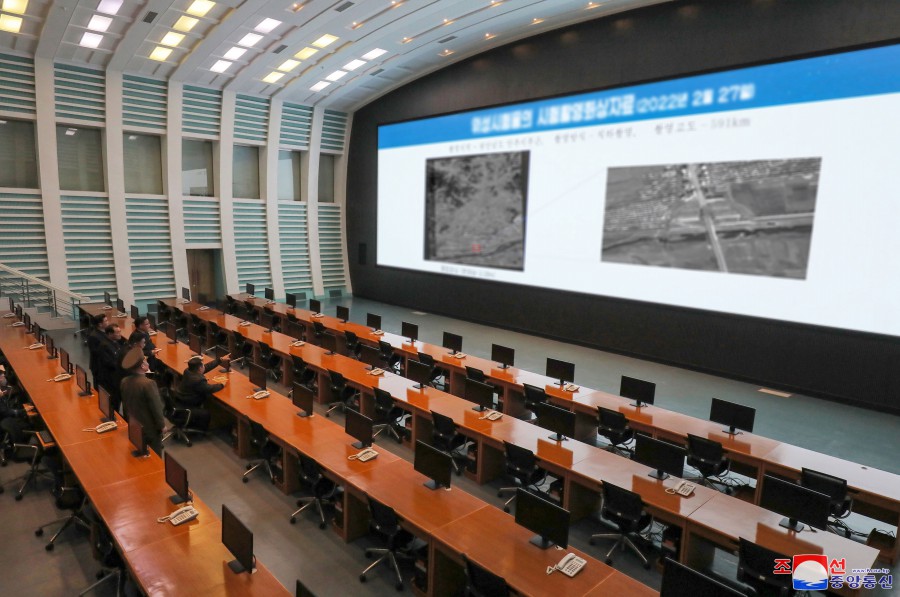
A North Korean Satellite Launch: What to Watch For
In the last two weeks, North Korea reported conducting two tests of military reconnaissance satellite technology. Another launch was reported by American and South Korean intelligence to have been conducted on March 16, although it is unclear whether satellite components were also part of that testing. Last week, Kim Jong Un visited the Sohae Satellite Launch Center, the country’s showcase space launch facility, and the National Aerospace Development Administration (NADA), giving guidance on further site development.[1]
The country’s space program has been largely out of the limelight since launches in 2012 and 2016 successfully put satellites into low Earth orbit, although those satellites failed to function. In January 2021, however, at the Eighth Congress of the Workers’ Party of Korea, Kim Jong Un disclosed that the design of a military reconnaissance satellite was complete, and the next step would be launching it.[2]
The Timing
North Korea hasn’t said when it plans to launch a satellite, but there is precedent for a launch in the runup to the 110th anniversary of Kim Il Sung’s birth (Day of the Sun) on April 15. North Korea often schedules events that can be seen as national triumphs around major anniversaries as part of a propaganda campaign. Moreover, on April 13, 2012, ahead of the 100th anniversary of Kim Il Sung’s birth, the country attempted to launch the Kwangmyongsong-3 satellite, although the launch was unsuccessful.
While North Korea doesn’t announce missile launches in advance, it has given prior notice of satellite launches in the past. This is usually done through navigation warnings to aviators and mariners submitted to the International Maritime Organization. It is part of North Korea’s assertion that its space program is like that of other countries and that it plays by the same rules.
The Space Launch Vehicle
North Korea’s three satellite launches in the last decade have used Unha-3 rockets. While it is possible a new launch could use the same Unha-3 rocket, recent actions suggest a more likely alternative.
Unlike normal missile test activity, North Korea did not release photos or video footage of the February 27 or March 6 launches but only reported on the satellite technology tested. However, about a week later, the US Department of Defense said the launches used the North’s new intercontinental ballistic missile (ICBM). The Hwasong-17 (화성포-17) ICBM was first unveiled at a military parade in Pyongyang on October 10, 2020, and was seen again at the “Self Defense-2021” expo in Pyongyang in October 2021. This missile is larger than the previous two ICBM designs, the Hwasong-14 and -15, which were flight tested in 2017, and is able to carry heavier payloads, including potentially multiple warheads and presumably, a military reconnaissance satellite.
Figure 1. The Hwasong-17 unveiled at the October 10, 2020 military parade.
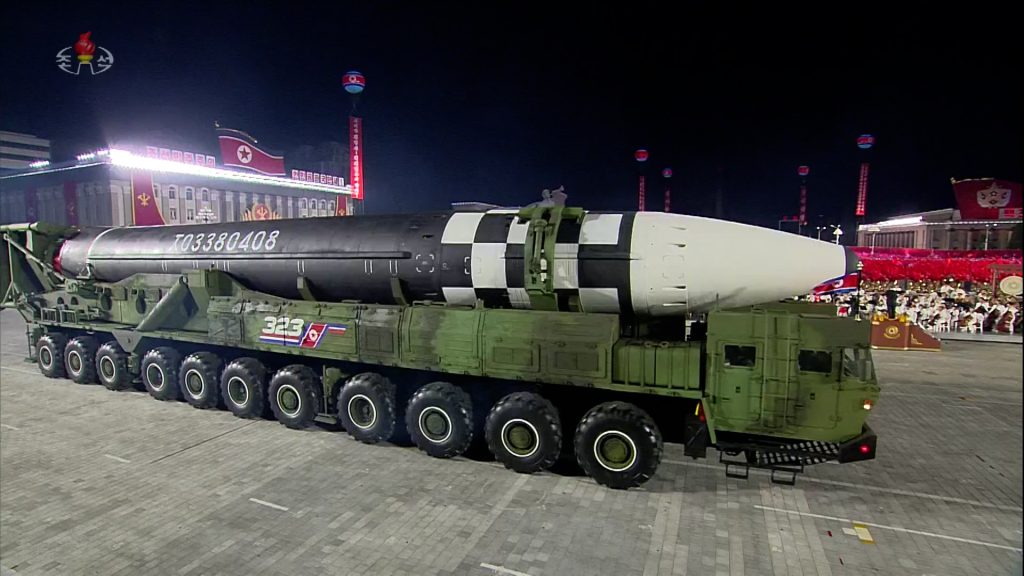 (Source: KCTV)
(Source: KCTV)
The Satellite
North Korean media has yet to provide any details on the planned “military reconnaissance satellite.” In the past, the state has shown off civilian satellites ahead of launch, but military satellites aren’t usually revealed by any nation. North Korea might choose to show it anyway, to prove it has a satellite to launch and make the case this isn’t just a cover for ICBM testing.
The satellite will likely be placed into a sun-synchronous orbit, which means it will pass over a given point at the same local solar time each day. That’s a typical orbit for an observation satellite, but the planned orbit should become clear once launch details are known.
It’s unclear what resolution images the satellite will capture, but state media provided a clue in photographs taken during Kim’s visit to NADA. On large screens in front of Kim, there appeared to be an image taken during the February 27 test launch. State media censors had blurred the image, but the image appeared to show Anju, a medium-sized town approximately 70 km (45 miles) north of Pyongyang. The resolution is difficult to determine from the blurred image but likely falls into the medium resolution range (see figure below for comparison).
Figure 2. Inside the National Aerospace Development Administration (NADA).
 (Source: KCNA)
(Source: KCNA)
Figure 3. A comparison of the image released by North Korean media (above) with images from Sentinel-2 at 10 m resolution (bottom left), Planet Scope at 3 m resolution (bottom center) and Planet SkySat at 0.5 m resolution (bottom right).
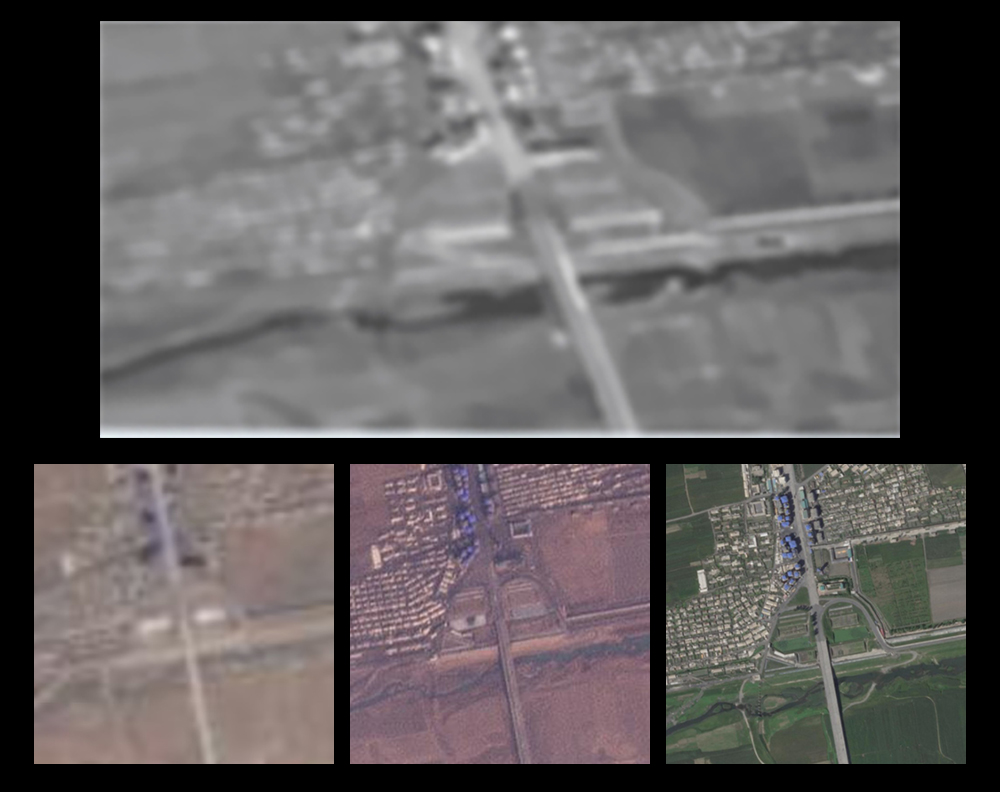 (Sources: KCNA, European Space Agency and Planet Labs)
(Sources: KCNA, European Space Agency and Planet Labs)
The Launch Site
North Korea’s first two space launches, in 1998 and 2009, took place from the Tonghae Satellite Launching Ground (also referred to as Musudan-ri) in the east of the country, but since 2012 all launches have been from the Sohae Satellite Launching Center (Tongchang-ri) on the west coast, and significant improvements have been made at Sohae over the years to increase capabilities at this site. This includes a larger launch tower, processing and checkout buildings on the launch pad, and a direct rail link to the launch pad, making it easier to conceal launch preparation activities. There is also a VIP observation facility and the NADA administration buildings at Sohae, allowing for optimal viewing for the leader and other VIPs.
The site has been largely quiet for the past few years, but changes might be afoot. Kim Jong Un visited Sohae on March 11 and gave instructions for its modernization, including the launch site and support buildings, the engine test stand and a grandstand to observe launches.[3]
Figure 4. Kim Jong Un at the Sohae Satellite Launching Ground on March 11, 2022.
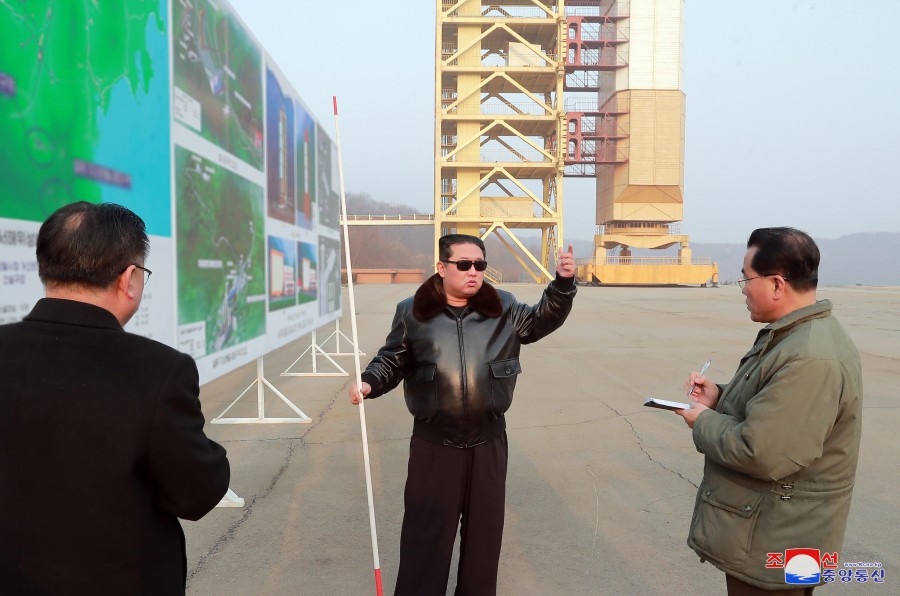 (Source: KCNA)
(Source: KCNA)
State media said all of this is required so that “various rockets could be launched to carry multi-purpose satellites, including a military reconnaissance satellite, in the future.”[4]
But if that statement was referring to the expected upcoming military reconnaissance satellite launch and it is indeed scheduled around April 15, there is no sign of any construction urgency at Sohae. A week after Kim Jong Un’s visit, the site is still quiet, with no observable work underway. This could mean the work won’t start until after the upcoming launch, the expectations for an imminent launch are wrong, or a different site will be used.
North Korea’s recent tests of satellite technology on the Hwasong-17 have taken place from Sunan International Airport near Pyongyang. There is no dedicated satellite launch facility at Sunan, but the Hwasong-17 can be launched off the back of a transporter-erector-launcher (TEL), opening the possibility that Sunan or another site could be used.
The Reaction
Something that is likely to remain unchanged from previous launches is the way North Korea frames the event and how the international community responds.
North Korea takes efforts to make its satellite launches appear like those of civilian space programs elsewhere in the world, especially, as mentioned, with warnings about where the rocket will fly and splash down into the ocean. This is a key difference with its missile launches.
But no matter the framing, the launch will almost certainly be criticized by the US and other nations as nothing more than a test of ICBM technology. The Department of Defense had already aired this complaint in reaction to the two recent tests when it said they were “likely to evaluate this new system before conducting a test at full range in the future, potentially disguised as a space launch.”
Brief Timeline of North Korean Space Program

A North Korean Satellite Launch: What to Watch For - 38 North: Informed Analysis of North Korea
It’s been six years since North Korea last launched a satellite, but now there are increasing signs that a new…
www.38north.org
A North Korean Satellite Launch: What to Watch For
- BY: MARTYN WILLIAMS
- MARCH 18, 2022
- MILITARY AFFAIRS, WMD
In the last two weeks, North Korea reported conducting two tests of military reconnaissance satellite technology. Another launch was reported by American and South Korean intelligence to have been conducted on March 16, although it is unclear whether satellite components were also part of that testing. Last week, Kim Jong Un visited the Sohae Satellite Launch Center, the country’s showcase space launch facility, and the National Aerospace Development Administration (NADA), giving guidance on further site development.[1]
The country’s space program has been largely out of the limelight since launches in 2012 and 2016 successfully put satellites into low Earth orbit, although those satellites failed to function. In January 2021, however, at the Eighth Congress of the Workers’ Party of Korea, Kim Jong Un disclosed that the design of a military reconnaissance satellite was complete, and the next step would be launching it.[2]
The Timing
North Korea hasn’t said when it plans to launch a satellite, but there is precedent for a launch in the runup to the 110th anniversary of Kim Il Sung’s birth (Day of the Sun) on April 15. North Korea often schedules events that can be seen as national triumphs around major anniversaries as part of a propaganda campaign. Moreover, on April 13, 2012, ahead of the 100th anniversary of Kim Il Sung’s birth, the country attempted to launch the Kwangmyongsong-3 satellite, although the launch was unsuccessful.
While North Korea doesn’t announce missile launches in advance, it has given prior notice of satellite launches in the past. This is usually done through navigation warnings to aviators and mariners submitted to the International Maritime Organization. It is part of North Korea’s assertion that its space program is like that of other countries and that it plays by the same rules.
The Space Launch Vehicle
North Korea’s three satellite launches in the last decade have used Unha-3 rockets. While it is possible a new launch could use the same Unha-3 rocket, recent actions suggest a more likely alternative.
Unlike normal missile test activity, North Korea did not release photos or video footage of the February 27 or March 6 launches but only reported on the satellite technology tested. However, about a week later, the US Department of Defense said the launches used the North’s new intercontinental ballistic missile (ICBM). The Hwasong-17 (화성포-17) ICBM was first unveiled at a military parade in Pyongyang on October 10, 2020, and was seen again at the “Self Defense-2021” expo in Pyongyang in October 2021. This missile is larger than the previous two ICBM designs, the Hwasong-14 and -15, which were flight tested in 2017, and is able to carry heavier payloads, including potentially multiple warheads and presumably, a military reconnaissance satellite.
Figure 1. The Hwasong-17 unveiled at the October 10, 2020 military parade.

The Satellite
North Korean media has yet to provide any details on the planned “military reconnaissance satellite.” In the past, the state has shown off civilian satellites ahead of launch, but military satellites aren’t usually revealed by any nation. North Korea might choose to show it anyway, to prove it has a satellite to launch and make the case this isn’t just a cover for ICBM testing.
The satellite will likely be placed into a sun-synchronous orbit, which means it will pass over a given point at the same local solar time each day. That’s a typical orbit for an observation satellite, but the planned orbit should become clear once launch details are known.
It’s unclear what resolution images the satellite will capture, but state media provided a clue in photographs taken during Kim’s visit to NADA. On large screens in front of Kim, there appeared to be an image taken during the February 27 test launch. State media censors had blurred the image, but the image appeared to show Anju, a medium-sized town approximately 70 km (45 miles) north of Pyongyang. The resolution is difficult to determine from the blurred image but likely falls into the medium resolution range (see figure below for comparison).
Figure 2. Inside the National Aerospace Development Administration (NADA).

Figure 3. A comparison of the image released by North Korean media (above) with images from Sentinel-2 at 10 m resolution (bottom left), Planet Scope at 3 m resolution (bottom center) and Planet SkySat at 0.5 m resolution (bottom right).

The Launch Site
North Korea’s first two space launches, in 1998 and 2009, took place from the Tonghae Satellite Launching Ground (also referred to as Musudan-ri) in the east of the country, but since 2012 all launches have been from the Sohae Satellite Launching Center (Tongchang-ri) on the west coast, and significant improvements have been made at Sohae over the years to increase capabilities at this site. This includes a larger launch tower, processing and checkout buildings on the launch pad, and a direct rail link to the launch pad, making it easier to conceal launch preparation activities. There is also a VIP observation facility and the NADA administration buildings at Sohae, allowing for optimal viewing for the leader and other VIPs.
The site has been largely quiet for the past few years, but changes might be afoot. Kim Jong Un visited Sohae on March 11 and gave instructions for its modernization, including the launch site and support buildings, the engine test stand and a grandstand to observe launches.[3]
Figure 4. Kim Jong Un at the Sohae Satellite Launching Ground on March 11, 2022.

State media said all of this is required so that “various rockets could be launched to carry multi-purpose satellites, including a military reconnaissance satellite, in the future.”[4]
But if that statement was referring to the expected upcoming military reconnaissance satellite launch and it is indeed scheduled around April 15, there is no sign of any construction urgency at Sohae. A week after Kim Jong Un’s visit, the site is still quiet, with no observable work underway. This could mean the work won’t start until after the upcoming launch, the expectations for an imminent launch are wrong, or a different site will be used.
North Korea’s recent tests of satellite technology on the Hwasong-17 have taken place from Sunan International Airport near Pyongyang. There is no dedicated satellite launch facility at Sunan, but the Hwasong-17 can be launched off the back of a transporter-erector-launcher (TEL), opening the possibility that Sunan or another site could be used.
The Reaction
Something that is likely to remain unchanged from previous launches is the way North Korea frames the event and how the international community responds.
North Korea takes efforts to make its satellite launches appear like those of civilian space programs elsewhere in the world, especially, as mentioned, with warnings about where the rocket will fly and splash down into the ocean. This is a key difference with its missile launches.
But no matter the framing, the launch will almost certainly be criticized by the US and other nations as nothing more than a test of ICBM technology. The Department of Defense had already aired this complaint in reaction to the two recent tests when it said they were “likely to evaluate this new system before conducting a test at full range in the future, potentially disguised as a space launch.”
Brief Timeline of North Korean Space Program
- August 31, 1998: Launch of Kwangmyongsong-1 satellite from Tonghae Satellite Launching Ground on a Paektusan-1 rocket. The US said the satellite failed to reach orbit.
- April 5, 2009: Launch of Kwangmyongsong-2 satellite from Tonghae Satellite Launching Ground on an Unha-2 rocket. The US and South Korea reported the launch failed, and the rocket and satellite crashed into the ocean.
- April 13, 2012: Launch of Kwangmyongsong-3 satellite from Sohae Satellite Launching Center on an Unha-3 rocket. The rocket broke up a minute into flight.
- December 12, 2012: Launch of the Kwangmyongsong 3-2 satellite from Sohae Satellite Launching Center on an Unha-3 rocket. The launch successfully placed the satellite in orbit, and North Korea declared it a success, but signals have never been independently observed.
- April 1, 2013: The 7th session of the 12th Supreme People’s Assembly (SPA) adopted a new law on space development and announced plans to form the National Aerospace Development Administration as the country’s space agency.
- May 2, 2015: Kim Jong Un visited the newly-built General Satellite Control Centre near Pyongyang.
- February 7, 2016: Launch of the Kwangmyongsong-4 satellite from Sohae Satellite Launch Center on an Unha-3 rocket. The rocket delivered the satellite into orbit, but signals were never detected, leading to a conclusion that it had malfunctioned.
- January 9, 2021: State media reported Kim Jong Un announced plans to launch a military reconnaissance satellite.
- February 27, 2022: Test launch of surveillance satellite technology from Sunan International Airport.
- March 5, 2022: Test launch of surveillance satellite technology from Sunan International Airport.
- March 9, 2022: Kim Jong Un visited the National Aerospace Development Administration.
- March 10, 2022: Kim Jong Un visited the Sohae Satellite Launching Center.
- March 16, 2022: North Korea conducted a further rocket test from Sunan International Airport, but it ended in failure, according to reports.
jward
passin' thru
Chinese Military Aircraft Crashed in South China Sea—Taiwan Intel Report
By John Feng On 3/10/22 at 6:49 AM EST
U.S. Navy Investigates Leaked Video Of F-35 Jet Crash In South China Sea
Share
Share on Facebook Share on Twitter Share on LinkedInShare on RedditShare on Flipboard Share via Email Comments
World China People's Liberation Army South China Sea Vietnam
The Chinese military is searching for a patrol plane that crashed into the South China Sea earlier this month, Taiwan's intelligence agency said on Thursday, becoming the first government in the region to officially confirm several days of speculation.
The March 1 accident involving a People's Liberation Army Air Force Y-8 anti-submarine warfare (ASW) aircraft was first revealed by Vietnam-based maritime analyst and open-source intelligence reporter Duan Dang in a Sunday issue of his Substack newsletter, South China Sea Brief. Chinese authorities had announced a "surprise military exercise" from March 4 to 15 in order to conceal the search and rescue efforts within a maritime no-go zone, Dang wrote.
In Taipei, a report presented to the legislature by the National Security Bureau linked the area of China's naval drills to the loss of the PLAAF asset, which it said had "crashed into the South China Sea in early March." Taiwan's chief of intelligence, Chen Ming-tong, declined to disclose further details about the source of his agency's intelligence.
In his newsletter on Wednesday, Dang noted China was still "actively searching" for the lost maritime patrol aircraft, and had brought in navy, coast guard and seabed research vessels as part of the large-scale operation taking place in the waters between Vietnam and the southern Chinese province of Hainan.
"The coast guard and research ships were only moving slowly within small areas, suggesting they were on a searching mission. Dozens of other naval ships were also continuously patrolling this area," Dang said.
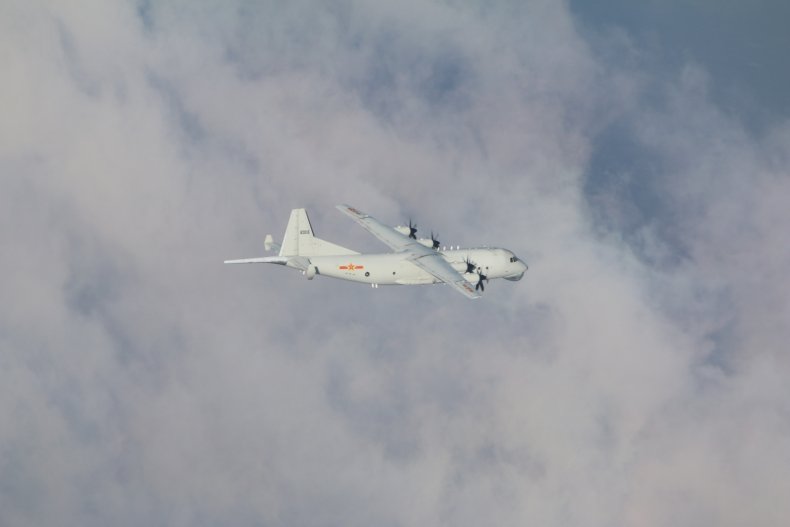
An undated file photo published by Taiwan’s Defense Ministry shows a Chinese air force Y-8 anti-submarine warfare aircraft detected inside Taiwan’s air defense identification zone. Taiwan’s intelligence agency confirmed in a report dated March 10, 2022, that the Chinese military was searching for a Y-8 aircraft that had crashed into the South China Sea in the beginning of the month. Ministry of National Defense, Taiwan
That the PLAAF appears to have grounded its entire fleet of Y-8 ASW aircraft adds more credibility to the reports, said Su Tzu-yun, an associate research fellow with the Institute for National Defense and Security Research, Taiwan's top defense think tank. "Standard aviation safety protocol calls for the inspection of all similar aircraft types following an accident," he told Newsweek.
Taiwan's Defense Ministry is continuing to track near-daily Chinese military flights into the southwest corner of the island's air defense identification zone, but the anti-submarine variant of the Y-8 has not been detected since March 1, the day of the reported South China Sea mishap. Meanwhile, the electronic warfare variant of the Y-8 has run missions into Taiwan's ADIZ on at least three occasions this month, the ministry's data shows.
Newsweek subscription offers >
Read more
China's Defense Ministry did not respond to separate requests for comment.
Earlier this month, the U.S. Navy announced the recovery of an F-35C Lightning II fighter jet after it fell into the South China Sea following a failed landing on the aircraft carrier USS Carl Vinson on January 24. The salvage operation, from a depth of 12,400 feet below the surface, took more than five weeks.
Reached on separate occasions since Dang's first report, the Japan-based U.S. 7th Fleet told Newsweek it had no details to share about the Chinese military's recent accident.
Pushing the Limits
On March 7, Vietnamese Foreign Ministry spokesperson Le Thi Thu Hang protested the extent of China's maritime no-go zone after saying it had violated Vietnam's exclusive economic zone. An illustration of the search area supplied by Dang shows it matching the boundaries of Beijing's so-called "nine-dash line," a sweeping maritime claim with no basis in international law.
In a response the following day, Chinese Foreign Ministry spokesperson Zhao Lijian said: "It is reasonable, lawful and irreproachable for China to conduct military exercises on its own doorstep."
Taiwan's intelligence agency said Beijing was taking advantage of the ongoing war in Ukraine to "test the limits" of its fellow South China Sea claimants.
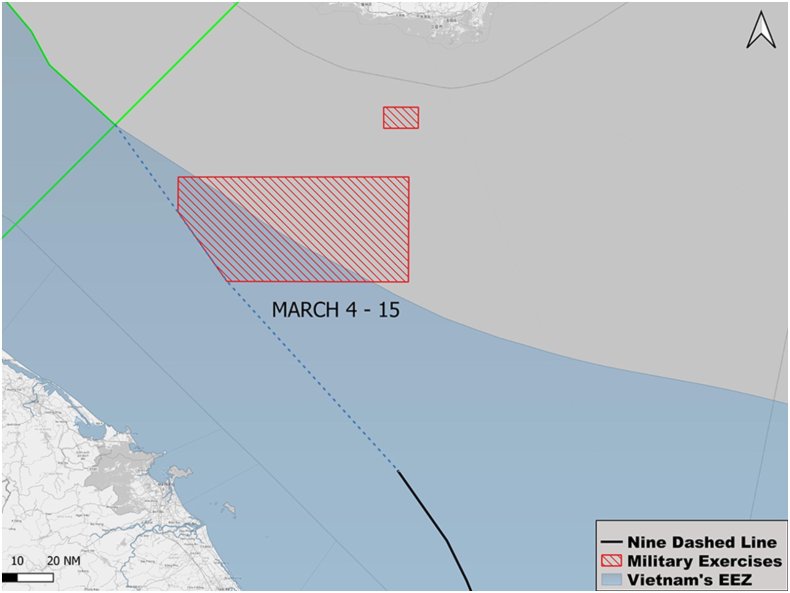
An illustration produced by maritime analyst Duan Dang shows the western edge of China’s maritime no-go zone following the boundaries of the so-called “nine-dash line,” which cuts into Vietnam’s exclusive economic zone. Duan Dang/South China Sea Brief
Request Reprint & Licensing, Submit Correction or view Editor
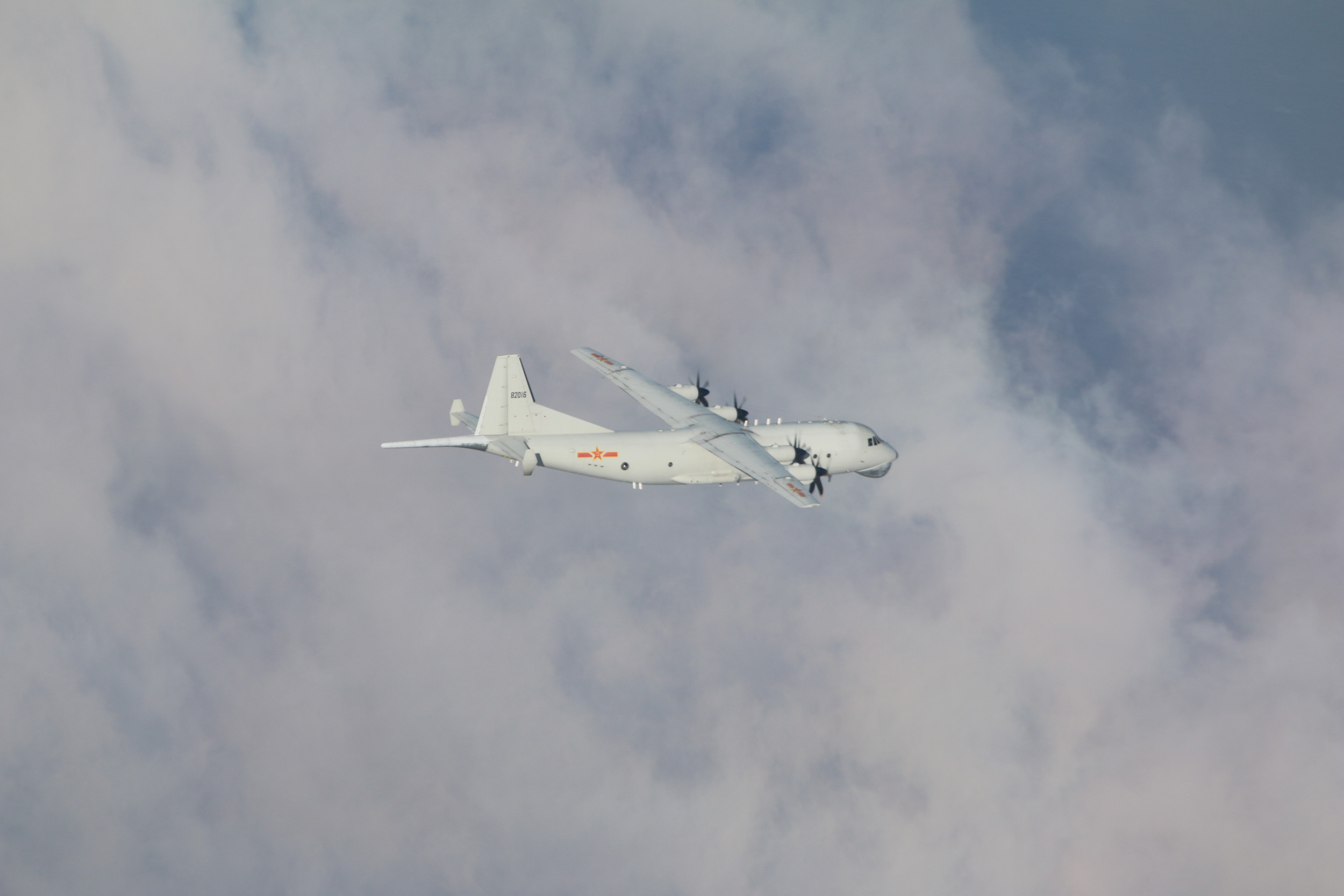
 www.newsweek.com
www.newsweek.com
By John Feng On 3/10/22 at 6:49 AM EST
U.S. Navy Investigates Leaked Video Of F-35 Jet Crash In South China Sea
Share
Share on Facebook Share on Twitter Share on LinkedInShare on RedditShare on Flipboard Share via Email Comments
World China People's Liberation Army South China Sea Vietnam
The Chinese military is searching for a patrol plane that crashed into the South China Sea earlier this month, Taiwan's intelligence agency said on Thursday, becoming the first government in the region to officially confirm several days of speculation.
The March 1 accident involving a People's Liberation Army Air Force Y-8 anti-submarine warfare (ASW) aircraft was first revealed by Vietnam-based maritime analyst and open-source intelligence reporter Duan Dang in a Sunday issue of his Substack newsletter, South China Sea Brief. Chinese authorities had announced a "surprise military exercise" from March 4 to 15 in order to conceal the search and rescue efforts within a maritime no-go zone, Dang wrote.
In Taipei, a report presented to the legislature by the National Security Bureau linked the area of China's naval drills to the loss of the PLAAF asset, which it said had "crashed into the South China Sea in early March." Taiwan's chief of intelligence, Chen Ming-tong, declined to disclose further details about the source of his agency's intelligence.
In his newsletter on Wednesday, Dang noted China was still "actively searching" for the lost maritime patrol aircraft, and had brought in navy, coast guard and seabed research vessels as part of the large-scale operation taking place in the waters between Vietnam and the southern Chinese province of Hainan.
"The coast guard and research ships were only moving slowly within small areas, suggesting they were on a searching mission. Dozens of other naval ships were also continuously patrolling this area," Dang said.

An undated file photo published by Taiwan’s Defense Ministry shows a Chinese air force Y-8 anti-submarine warfare aircraft detected inside Taiwan’s air defense identification zone. Taiwan’s intelligence agency confirmed in a report dated March 10, 2022, that the Chinese military was searching for a Y-8 aircraft that had crashed into the South China Sea in the beginning of the month. Ministry of National Defense, Taiwan
That the PLAAF appears to have grounded its entire fleet of Y-8 ASW aircraft adds more credibility to the reports, said Su Tzu-yun, an associate research fellow with the Institute for National Defense and Security Research, Taiwan's top defense think tank. "Standard aviation safety protocol calls for the inspection of all similar aircraft types following an accident," he told Newsweek.
Taiwan's Defense Ministry is continuing to track near-daily Chinese military flights into the southwest corner of the island's air defense identification zone, but the anti-submarine variant of the Y-8 has not been detected since March 1, the day of the reported South China Sea mishap. Meanwhile, the electronic warfare variant of the Y-8 has run missions into Taiwan's ADIZ on at least three occasions this month, the ministry's data shows.
Newsweek subscription offers >
Read more
- China Is Learning Lessons From West's United Response to Russia
- China Omits Ukraine As It Backs Postwar Talks Between West and Russia
- US Says Ukraine 'Diagnostic, Biodefense' Labs Have No 'Biological Weapons'
China's Defense Ministry did not respond to separate requests for comment.
Earlier this month, the U.S. Navy announced the recovery of an F-35C Lightning II fighter jet after it fell into the South China Sea following a failed landing on the aircraft carrier USS Carl Vinson on January 24. The salvage operation, from a depth of 12,400 feet below the surface, took more than five weeks.
Reached on separate occasions since Dang's first report, the Japan-based U.S. 7th Fleet told Newsweek it had no details to share about the Chinese military's recent accident.
Pushing the Limits
On March 7, Vietnamese Foreign Ministry spokesperson Le Thi Thu Hang protested the extent of China's maritime no-go zone after saying it had violated Vietnam's exclusive economic zone. An illustration of the search area supplied by Dang shows it matching the boundaries of Beijing's so-called "nine-dash line," a sweeping maritime claim with no basis in international law.
In a response the following day, Chinese Foreign Ministry spokesperson Zhao Lijian said: "It is reasonable, lawful and irreproachable for China to conduct military exercises on its own doorstep."
Taiwan's intelligence agency said Beijing was taking advantage of the ongoing war in Ukraine to "test the limits" of its fellow South China Sea claimants.

An illustration produced by maritime analyst Duan Dang shows the western edge of China’s maritime no-go zone following the boundaries of the so-called “nine-dash line,” which cuts into Vietnam’s exclusive economic zone. Duan Dang/South China Sea Brief
Request Reprint & Licensing, Submit Correction or view Editor

Chinese Military Aircraft Crashed in South China Sea—Taiwan Intel Report
The Chinese air force's fleet of Y-8 anti-submarine aircraft has not been detected in flight operations near Taiwan since March 1.
jward
passin' thru
HMM

Chad O'Carroll
@chadocl
North Korea fired off multiple rocket launcher shots into the West Sea from 07.18, for one hour, Chosun Ilbo reports. But not clear yet whether these were targeted towards the direction of South Korea or just into seas west of DPRK. Yonhap say an NSC emergency meeting held.
Context: After Park Geun-hye's inauguration in 2013, Kim Jong Un visited forward-deployed island defense detachments near the inter-Korean border, as well as watched live-fire drills in nearby and sensitive areas. This contributed to inter-Korean tension at the time.
Update: Yonhap said four suspected shots from the MLRS from South Pyongyan Province This location isn't too sensitive, IMO, for this kind of North Korean MLRS activity.
View: https://twitter.com/chadocl/status/1505404615017533443?s=20&t=cFb-0u-euUeJFcjkIzB_wQ
11:31 PM · Mar 19, 2022·Twitter Web App
Replying to
@chadocl
and
@ELINTNews
Do you know why into the western sea in this case, instead of the usual eastern sea, as for their missile tests?
Replying to
@chadocl
and
@ELINTNews
They are testing their limits. They will continue to escalate the situation until someone tells them to stop. Sounds familiar doesn't it?

Chad O'Carroll
@chadocl
North Korea fired off multiple rocket launcher shots into the West Sea from 07.18, for one hour, Chosun Ilbo reports. But not clear yet whether these were targeted towards the direction of South Korea or just into seas west of DPRK. Yonhap say an NSC emergency meeting held.
Context: After Park Geun-hye's inauguration in 2013, Kim Jong Un visited forward-deployed island defense detachments near the inter-Korean border, as well as watched live-fire drills in nearby and sensitive areas. This contributed to inter-Korean tension at the time.
Update: Yonhap said four suspected shots from the MLRS from South Pyongyan Province This location isn't too sensitive, IMO, for this kind of North Korean MLRS activity.
View: https://twitter.com/chadocl/status/1505404615017533443?s=20&t=cFb-0u-euUeJFcjkIzB_wQ
11:31 PM · Mar 19, 2022·Twitter Web App
Replying to
@chadocl
and
@ELINTNews
Do you know why into the western sea in this case, instead of the usual eastern sea, as for their missile tests?
Replying to
@chadocl
and
@ELINTNews
They are testing their limits. They will continue to escalate the situation until someone tells them to stop. Sounds familiar doesn't it?
jward
passin' thru
Brahma Chellaney
@Chellaney
22h
BENDING OVER BACKWARDS: Biden tells Xi "US does not seek a new Cold War with China; does not aim to change China’s system; the revitalization of its alliances is not targeted at China; US does not support 'Taiwan independence'; and has no intention to seek a conflict with China."
@Chellaney
22h
BENDING OVER BACKWARDS: Biden tells Xi "US does not seek a new Cold War with China; does not aim to change China’s system; the revitalization of its alliances is not targeted at China; US does not support 'Taiwan independence'; and has no intention to seek a conflict with China."
Brahma Chellaney
@Chellaney
22h
BENDING OVER BACKWARDS: Biden tells Xi "US does not seek a new Cold War with China; does not aim to change China’s system; the revitalization of its alliances is not targeted at China; US does not support 'Taiwan independence'; and has no intention to seek a conflict with China."
Biden’s lack of a backbone will lead us into war, with our enemies knowing that there is NO leader in Washington. Sooner or later, Americans will be fighting wars of desperation around the world, out-numbered, out-gunned, and without benefit of a national command structure or authority. Our children will be in grave peril, because America voted for a demented traitor, and his corrupt, treasonous party.
OA
jward
passin' thru
AP Exclusive: US admiral says China fully militarized isles
By JIM GOMEZ and AARON FAVILAtoday

1 of 21
Admiral John C. Aquilino, left, Commander of the U.S. Indo-Pacific Command (INDOPACOM), looks at videos of Chinese structures and buildings on board a US P-8A Poseidon reconaisance plane flying at the Spratlys group of islands in the South China Sea on Sunday March 20, 2022. A U.S. Navy plane carrying a top American military commander was threatened repeatedly by radio on Sunday to leave the airspace over Chinese-occupied island garrisons in the disputed South China Sea, but the aircraft pressed on defiantly with its reconnaissance in brief but tense standoffs witnessed by two Associated Press journalists invited onboard. (AP Photo/Aaron Favila)
OVER THE SOUTH CHINA SEA (AP) — China has fully militarized at least three of several islands it built in the disputed South China Sea, arming them with anti-ship and anti-aircraft missile systems, laser and jamming equipment, and fighter jets in an increasingly aggressive move that threatens all nations operating nearby, a top U.S. military commander said Sunday.
U.S. Indo-Pacific commander Adm. John C. Aquilino said the hostile actions were in stark contrast to Chinese President Xi Jinping’s past assurances that Beijing would not transform the artificial islands in contested waters into military bases. The efforts were part of China’s flexing its military muscle, he said.
“I think over the past 20 years we’ve witnessed the largest military buildup since World War II by the PRC,” Aquilino told The Associated Press in an interview, using the initials of China’s formal name. “They have advanced all their capabilities and that buildup of weaponization is destabilizing to the region.”
There were no immediate comments from Chinese officials. Beijing maintains its military profile is purely defensive, arranged to protect what it says are its sovereign rights. But after years of increased military spending, China now boasts the world’s second-largest defense budget after the U.S. and is rapidly modernizing its force with weapons systems including the J-20 stealth fighter, hypersonic missiles and two aircraft carriers, with a third under construction.
Business
“China has sovereignty over the Spratly islands, as well as surrounding maritime areas. Stay away immediately to avoid misjudgment,” one of the stern radio messages said in a veiled threat.
But the U.S. Navy plane dismissed the multiple warnings and pressed on defiantly with its reconnaissance in brief but tense moments witnessed by two AP journalists invited onboard. “I am a sovereign immune United States naval aircraft conducting lawful military activities beyond the national airspace of any coastal state,” a U.S. pilot radioed back to the Chinese.
“Exercising these rights is guaranteed by international law and I am operating with due regard to the rights and duties of all states,” he said.
Navy commanding officer Joel Martinez, who led the P-8A Poseidon’s crew, said there has been an incident when a Chinese jet flew close to a U.S. aircraft in a dangerous maneuver in the disputed region. The U.S. flight crew calmly reminded the Chinese to comply with aviation safety regulations, he said.
As the P-8A Poseidon flew as low as 15,000 feet (4,500 meters) near the Chinese-occupied reefs, some appeared to be like small cities on screen monitors, with multi-story buildings, warehouses, hangars, seaports, runways and white round structures Aquilino said were radars. Near Fiery Cross, more than 40 unspecified vessels could be seen apparently anchored.
Aquilino said the construction of missile arsenals, aircraft hangars, radar systems and other military facilities on Mischief Reef, Subi Reef and Fiery Cross appeared to have been completed but it remains to be seen if China will pursue the construction of military infrastructure in other areas.
“The function of those islands is to expand the offensive capability of the PRC beyond their continental shores,” he said. “They can fly fighters, bombers plus all those offensive capabilities of missile systems.”
He said any military and civilian plane flying over the disputed waterway could easily get within range of the Chinese islands’ missile system.
“So that’s the threat that exists, that’s why it’s so concerning for the militarization of these islands,” he said. “They threaten all nations who operate in the vicinity and all the international sea and airspace.”
China sought to shore up its vast territorial claims over virtually the entire South China Sea by building island bases on coral atolls nearly a decade ago. The U.S. responded by sending its warships through the region in what it calls freedom of operation missions. The United States has no claims itself but has deployed Navy ships and aircraft for decades to patrol and promote free navigation in international waterway and airspace.
China routinely objects to any action by the U.S. military in the region. The other parties — the Philippines, Vietnam, Malaysia, Taiwan and Brunei — claim all or part of the sea, through which approximately $5 trillion in goods are shipped every year.
Despite China’s aggression, the long-simmering territorial conflicts should only be resolved peacefully, Aquilino said, and cited the Philippine government’s successful move to bring its disputes with China to international arbitration in 2013 as a good template.
A U.N.-backed arbitration tribunal that handled the case invalidated China’s sweeping historical claims in the South China Sea under the U.N. Convention on the Law of the Sea. Beijing dismissed the ruling as sham and continues to defy it.
Washington’s main objective in the disputed region is “to prevent war” through deterrence and promote peace and stability, including by engaging American allies and partners in projects with that objective, Aquilino said.
“Should deterrence fail, my second mission is to be prepared to fight and win,” said Aquilino, who leads the largest U.S. combatant command with 380,000 military and civilian personnel covering 36 nations and territories.
___
Associated Press writer David Rising in Bangkok contributed to this report.
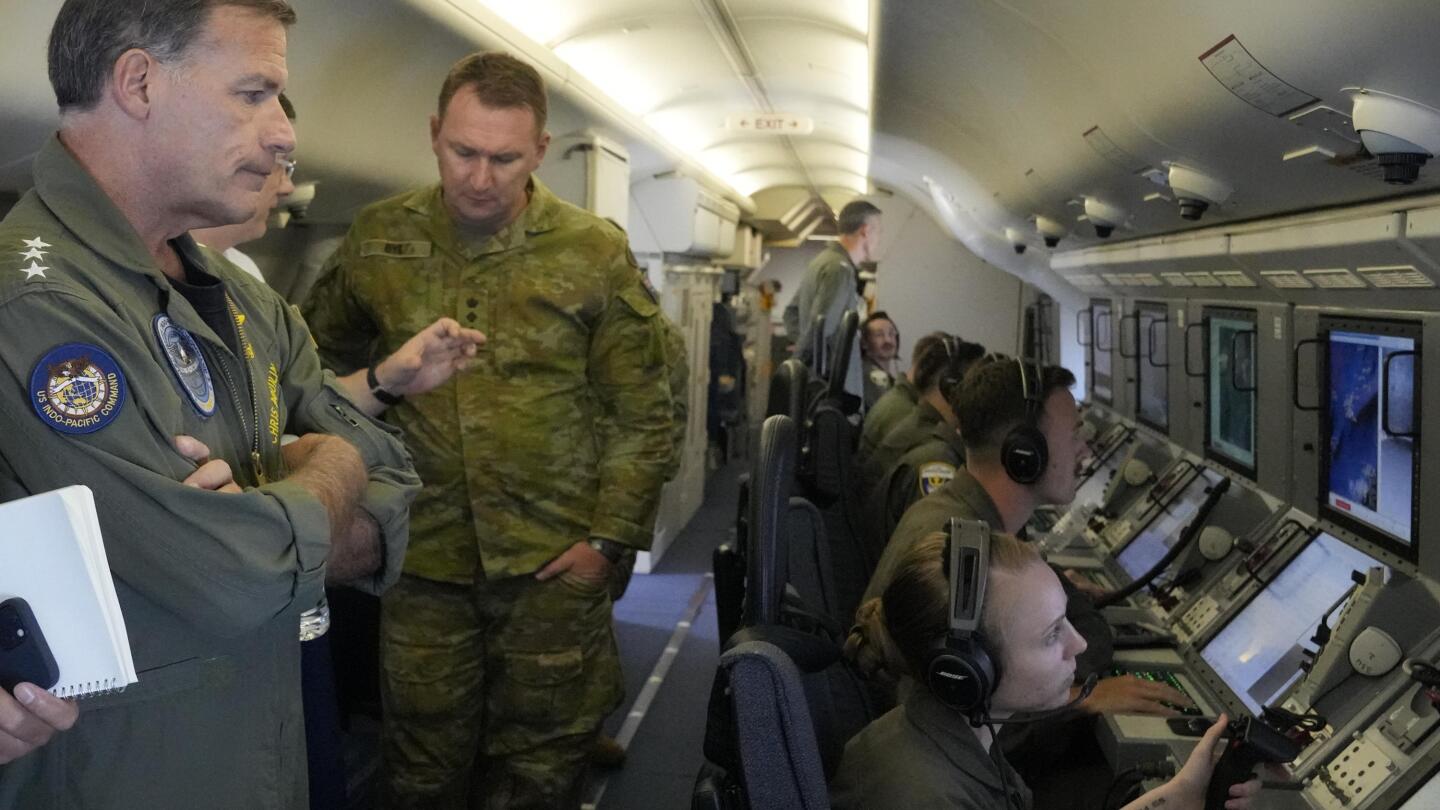
 apnews.com
apnews.com
By JIM GOMEZ and AARON FAVILAtoday

1 of 21
Admiral John C. Aquilino, left, Commander of the U.S. Indo-Pacific Command (INDOPACOM), looks at videos of Chinese structures and buildings on board a US P-8A Poseidon reconaisance plane flying at the Spratlys group of islands in the South China Sea on Sunday March 20, 2022. A U.S. Navy plane carrying a top American military commander was threatened repeatedly by radio on Sunday to leave the airspace over Chinese-occupied island garrisons in the disputed South China Sea, but the aircraft pressed on defiantly with its reconnaissance in brief but tense standoffs witnessed by two Associated Press journalists invited onboard. (AP Photo/Aaron Favila)
OVER THE SOUTH CHINA SEA (AP) — China has fully militarized at least three of several islands it built in the disputed South China Sea, arming them with anti-ship and anti-aircraft missile systems, laser and jamming equipment, and fighter jets in an increasingly aggressive move that threatens all nations operating nearby, a top U.S. military commander said Sunday.
U.S. Indo-Pacific commander Adm. John C. Aquilino said the hostile actions were in stark contrast to Chinese President Xi Jinping’s past assurances that Beijing would not transform the artificial islands in contested waters into military bases. The efforts were part of China’s flexing its military muscle, he said.
“I think over the past 20 years we’ve witnessed the largest military buildup since World War II by the PRC,” Aquilino told The Associated Press in an interview, using the initials of China’s formal name. “They have advanced all their capabilities and that buildup of weaponization is destabilizing to the region.”
There were no immediate comments from Chinese officials. Beijing maintains its military profile is purely defensive, arranged to protect what it says are its sovereign rights. But after years of increased military spending, China now boasts the world’s second-largest defense budget after the U.S. and is rapidly modernizing its force with weapons systems including the J-20 stealth fighter, hypersonic missiles and two aircraft carriers, with a third under construction.
Business
- Russian bond trading resumes for 1st time since Ukraine war
- Canadian Pacific rail work stoppage could hit US agriculture
- Labor foe Schultz returns as Starbucks union effort grows
- EU slams 'war crimes' in Ukraine but new sanctions unlikely
“China has sovereignty over the Spratly islands, as well as surrounding maritime areas. Stay away immediately to avoid misjudgment,” one of the stern radio messages said in a veiled threat.
But the U.S. Navy plane dismissed the multiple warnings and pressed on defiantly with its reconnaissance in brief but tense moments witnessed by two AP journalists invited onboard. “I am a sovereign immune United States naval aircraft conducting lawful military activities beyond the national airspace of any coastal state,” a U.S. pilot radioed back to the Chinese.
“Exercising these rights is guaranteed by international law and I am operating with due regard to the rights and duties of all states,” he said.
Navy commanding officer Joel Martinez, who led the P-8A Poseidon’s crew, said there has been an incident when a Chinese jet flew close to a U.S. aircraft in a dangerous maneuver in the disputed region. The U.S. flight crew calmly reminded the Chinese to comply with aviation safety regulations, he said.
As the P-8A Poseidon flew as low as 15,000 feet (4,500 meters) near the Chinese-occupied reefs, some appeared to be like small cities on screen monitors, with multi-story buildings, warehouses, hangars, seaports, runways and white round structures Aquilino said were radars. Near Fiery Cross, more than 40 unspecified vessels could be seen apparently anchored.
Aquilino said the construction of missile arsenals, aircraft hangars, radar systems and other military facilities on Mischief Reef, Subi Reef and Fiery Cross appeared to have been completed but it remains to be seen if China will pursue the construction of military infrastructure in other areas.
“The function of those islands is to expand the offensive capability of the PRC beyond their continental shores,” he said. “They can fly fighters, bombers plus all those offensive capabilities of missile systems.”
He said any military and civilian plane flying over the disputed waterway could easily get within range of the Chinese islands’ missile system.
“So that’s the threat that exists, that’s why it’s so concerning for the militarization of these islands,” he said. “They threaten all nations who operate in the vicinity and all the international sea and airspace.”
China sought to shore up its vast territorial claims over virtually the entire South China Sea by building island bases on coral atolls nearly a decade ago. The U.S. responded by sending its warships through the region in what it calls freedom of operation missions. The United States has no claims itself but has deployed Navy ships and aircraft for decades to patrol and promote free navigation in international waterway and airspace.
China routinely objects to any action by the U.S. military in the region. The other parties — the Philippines, Vietnam, Malaysia, Taiwan and Brunei — claim all or part of the sea, through which approximately $5 trillion in goods are shipped every year.
Despite China’s aggression, the long-simmering territorial conflicts should only be resolved peacefully, Aquilino said, and cited the Philippine government’s successful move to bring its disputes with China to international arbitration in 2013 as a good template.
A U.N.-backed arbitration tribunal that handled the case invalidated China’s sweeping historical claims in the South China Sea under the U.N. Convention on the Law of the Sea. Beijing dismissed the ruling as sham and continues to defy it.
Washington’s main objective in the disputed region is “to prevent war” through deterrence and promote peace and stability, including by engaging American allies and partners in projects with that objective, Aquilino said.
“Should deterrence fail, my second mission is to be prepared to fight and win,” said Aquilino, who leads the largest U.S. combatant command with 380,000 military and civilian personnel covering 36 nations and territories.
___
Associated Press writer David Rising in Bangkok contributed to this report.

AP Exclusive: US admiral says China fully militarized isles
A top U.S. commander says China has fully militarized at least three of several islands it built in the disputed South China Sea and has armed them with anti-ship and anti-aircraft missile systems, laser and jamming equipment, and fighter jets.
jward
passin' thru
Duterte warns of Chinese ‘invasion’ once Putin uses nukes
By LLANESCA T. PANTI, GMA News
Published March 21, 2022 7:59pm
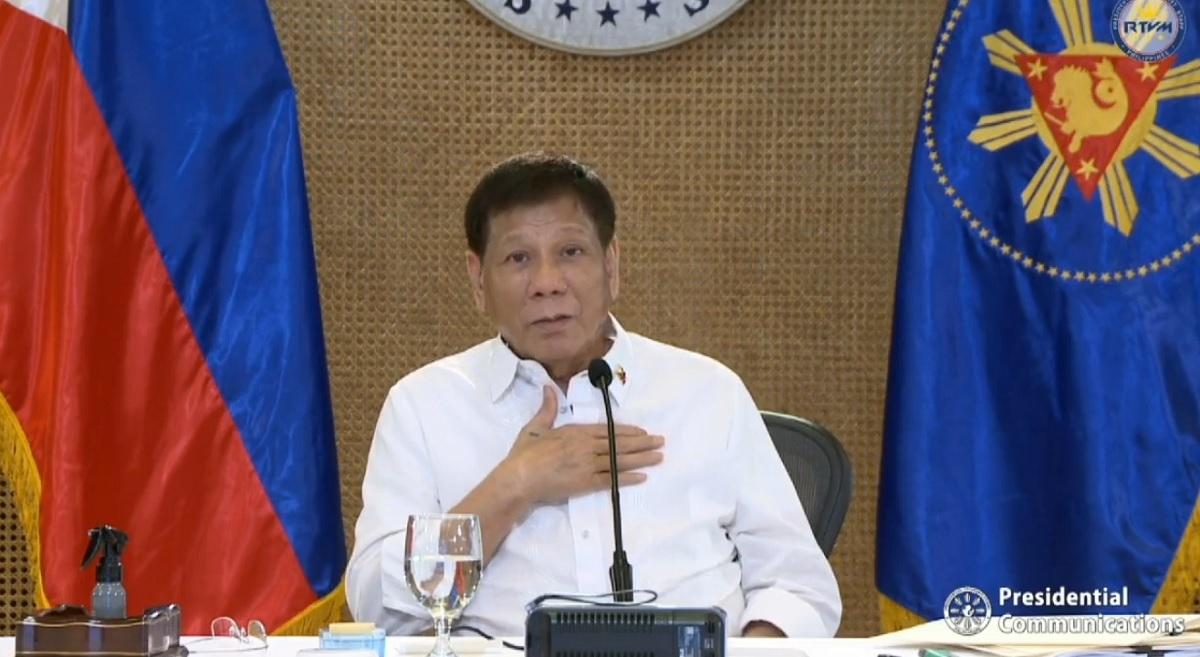
President Rodrigo Duterte on Monday warned of a Chinese "invasion" should Russian President Vladimir Putin decide to use nuclear weapons in the Ukraine conflict.
President Rodrigo Duterte on Monday warned of a Chinese "invasion" should Russian President Vladimir Putin decide to use nuclear weapons in the Ukraine conflict.
Duterte made the remarks amid the ongoing armed conflict between Russia and Ukraine which began on February 23.
"Kung talagang maipit si Putin at pindutin iyong pulang button, wala na. Then my thinking is...pag mag ganun 'yan...China will invade...sa intelligence briefing, tatamaan talaga tayo," Duterte said during a Malacañan ceremony during which several measures were signed into law.
"That was my reason why them [Americans] are unrestricted [here]. Pipilitin ng mga Amerikano eh. Talagang brusko ang mga Amerikano," Duterte added.
Duterte then said that a nuclear attack can be initially invisible.
Other Stories
Duterte orders monthly 'ayuda' hiked from P200 to P500
CSC has been supporting 4-day workweek since pandemic onset –Lizada
Congressman Teves' son tagged in punching village security guard
"Hindi lang natin makita iyong nuclear, iyong long range bombers... baka napindot na kanina [ang button] rito sa South China Sea. It will reach our jurisdiction in seven minutes. Iyong hypersonic ano nila...so kasali tayo diyan. Let us not kid each other," Duterte said.
"Kaya andito ang Amerika, that is the reason I gave the order to the military to allow them unrestricted [movement] para matapos...wag lang sana [na] iyong China [would resort to invasion]," Duterte added.
Duterte then said that back when he met Russian President Vladimir Putin in May 2017, the Russian leader assured him that he would talk to China over Beijing's militarization and aggression in the South China Sea, a portion of which is in the Philippines' exclusive economic zone.
Duterte said Putin's effort did not prosper.
"Tatlo lang kami: [Senator] Bong Go, Defense Secretary Delfin Lorenzana, ako. Sinabi talaga ni Putin, we will try to help you, we will talk to China. But China never listened to the advice of anybody. Tatamaan talaga tayo, sigurado. But I will not send my soldiers upon the request of anybody to join the cause against Russia," Duterte added.
— DVM, GMA News

 www.gmanetwork.com
www.gmanetwork.com
By LLANESCA T. PANTI, GMA News
Published March 21, 2022 7:59pm

President Rodrigo Duterte on Monday warned of a Chinese "invasion" should Russian President Vladimir Putin decide to use nuclear weapons in the Ukraine conflict.
President Rodrigo Duterte on Monday warned of a Chinese "invasion" should Russian President Vladimir Putin decide to use nuclear weapons in the Ukraine conflict.
Duterte made the remarks amid the ongoing armed conflict between Russia and Ukraine which began on February 23.
"Kung talagang maipit si Putin at pindutin iyong pulang button, wala na. Then my thinking is...pag mag ganun 'yan...China will invade...sa intelligence briefing, tatamaan talaga tayo," Duterte said during a Malacañan ceremony during which several measures were signed into law.
"That was my reason why them [Americans] are unrestricted [here]. Pipilitin ng mga Amerikano eh. Talagang brusko ang mga Amerikano," Duterte added.
Duterte then said that a nuclear attack can be initially invisible.
Other Stories
Duterte orders monthly 'ayuda' hiked from P200 to P500
CSC has been supporting 4-day workweek since pandemic onset –Lizada
Congressman Teves' son tagged in punching village security guard
"Hindi lang natin makita iyong nuclear, iyong long range bombers... baka napindot na kanina [ang button] rito sa South China Sea. It will reach our jurisdiction in seven minutes. Iyong hypersonic ano nila...so kasali tayo diyan. Let us not kid each other," Duterte said.
"Kaya andito ang Amerika, that is the reason I gave the order to the military to allow them unrestricted [movement] para matapos...wag lang sana [na] iyong China [would resort to invasion]," Duterte added.
Duterte then said that back when he met Russian President Vladimir Putin in May 2017, the Russian leader assured him that he would talk to China over Beijing's militarization and aggression in the South China Sea, a portion of which is in the Philippines' exclusive economic zone.
Duterte said Putin's effort did not prosper.
"Tatlo lang kami: [Senator] Bong Go, Defense Secretary Delfin Lorenzana, ako. Sinabi talaga ni Putin, we will try to help you, we will talk to China. But China never listened to the advice of anybody. Tatamaan talaga tayo, sigurado. But I will not send my soldiers upon the request of anybody to join the cause against Russia," Duterte added.
— DVM, GMA News

Duterte warns of Chinese ‘invasion’ once Putin uses nukes
President Rodrigo Duterte on Monday warned of a Chinese "invasion" should Russian President Vladimir Putin decide to use nuclear weapons in the Ukraine conflict.
jward
passin' thru
Samuel Ramani
@SamRamani2
6h
BREAKING: Russia and North Korea discuss "developing bilateral relations"
@SamRamani2
6h
BREAKING: Russia and North Korea discuss "developing bilateral relations"
jward
passin' thru

SCS Probing Initiative
@SCS_PI
22m
Three US surveillance ships have been simultaneously operating in and around the #SCS recently: USNS Bowditch (T-AGS-62) to the south of Hainan Island, USNS Effective(T-AGOS-21) to the north of Scarborough Shoal, and USNS Loyal (T-AGOS-22) to the east of Taiwan Island, Mar 17-23.

jward
passin' thru
ANI
@ANI
India today successfully testfired surface to surface BrahMos supersonic cruise missile in Andaman & Nicobar. Extended range missile hit its target with pinpoint accuracy: Defence officials
Air Chief Marshal VR Chaudhari congratulated on the successful test-firing of surface to surface BrahMos supersonic cruise missile. He is in the Island territory of Andaman & Nicobar to review operational preparedness: Defence officials
View: https://twitter.com/ANI/status/1506624154451456001?s=20&t=0j8eQATkmqalvUya0E81vg
@ANI
India today successfully testfired surface to surface BrahMos supersonic cruise missile in Andaman & Nicobar. Extended range missile hit its target with pinpoint accuracy: Defence officials
Air Chief Marshal VR Chaudhari congratulated on the successful test-firing of surface to surface BrahMos supersonic cruise missile. He is in the Island territory of Andaman & Nicobar to review operational preparedness: Defence officials
View: https://twitter.com/ANI/status/1506624154451456001?s=20&t=0j8eQATkmqalvUya0E81vg
onetimer
Veteran Member
The Intel Frog@TheIntelFrog
This is a pretty good indicator of an imminent missile launch by North Korea. We'll see.
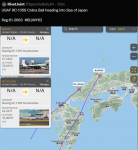
View: https://twitter.com/TheIntelFrog/status/1506699976042295299?s=20&t=Zh_iiFwKRLWbkRQSpkXAYQ
This is a pretty good indicator of an imminent missile launch by North Korea. We'll see.

View: https://twitter.com/TheIntelFrog/status/1506699976042295299?s=20&t=Zh_iiFwKRLWbkRQSpkXAYQ
jward
passin' thru
Yonhap News Agency
@YonhapNews
39s
(LEAD) Moon calls for meeting with Yoon without conditions
View: https://twitter.com/YonhapNews/status/1506822735867314181?s=20&t=JzvOqhi-sd_omVxAM7B6Zg
@YonhapNews
39s
(LEAD) Moon calls for meeting with Yoon without conditions
View: https://twitter.com/YonhapNews/status/1506822735867314181?s=20&t=JzvOqhi-sd_omVxAM7B6Zg
Yonhap News Agency
@YonhapNews
39s
(LEAD) Moon calls for meeting with Yoon without conditions
View: https://twitter.com/YonhapNews/status/1506822735867314181?s=20&t=JzvOqhi-sd_omVxAM7B6Zg
Hummm......
onetimer
Veteran Member
(URGENT) N.Korea fires a suspected long-range ballistic missile: S. Korean military (URGENT) N.Korea fires a suspected long-range ballistic missile: S. Korean military | Yonhap News Agency
View: https://twitter.com/YonhapNews/status/1506875497388863488?t=6WaarZ7hWtsp6xZDpEQHUA&s=19
View: https://twitter.com/YonhapNews/status/1506875497388863488?t=6WaarZ7hWtsp6xZDpEQHUA&s=19
onetimer
Veteran Member
It's the big one, according to South Korea: North Korea used an intercontinental ballistic missile (ICBM) in today's test, Yonhap reports. Could be first full-range ICBM test since 2017
View: https://twitter.com/joshjonsmith/status/1506877306735783936?t=gGq9YDA2Yb56U814Trt-oA&s=19
View: https://twitter.com/joshjonsmith/status/1506877306735783936?t=gGq9YDA2Yb56U814Trt-oA&s=19
It's the big one, according to South Korea: North Korea used an intercontinental ballistic missile (ICBM) in today's test, Yonhap reports. Could be first full-range ICBM test since 2017
View: https://twitter.com/joshjonsmith/status/1506877306735783936?t=gGq9YDA2Yb56U814Trt-oA&s=19
Merde....
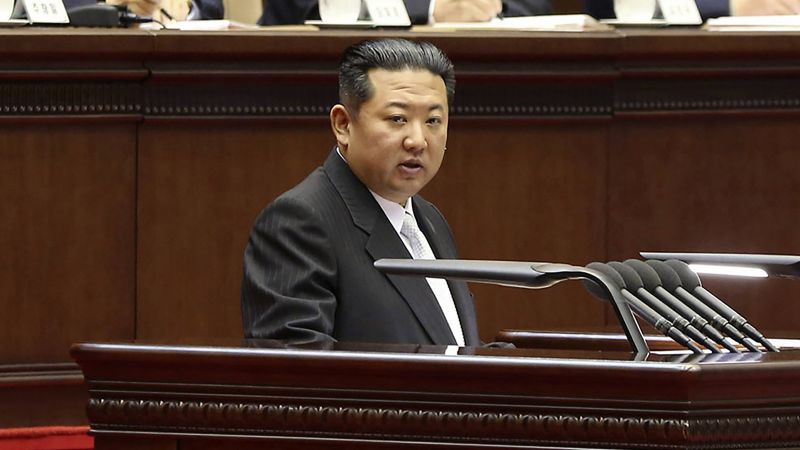
North Korea fires first suspected ICBM since 2017 | CNN
North Korea has fired what is believed to be its first intercontinental ballistic missile (ICBM) in more than four years as Western leaders gather in Brussels for a security summit.
By Yoonjung Seo, Gawon Bae and Emiko Jozuka, CNN
Published 2:16 AM EDT, Thu March 24, 2022
Seoul, South KoreaCNN —
North Korea fired a “possible ballistic missile” on Thursday into the waters east of Japan, the Japanese Prime Minister’s office said in a statement posted online.
South Korea also reported the launch, with the South Korean Joint Chiefs of Staff saying in a statement that Seoul was still trying to determine how many projectiles had been fired.
If confirmed, Thursday’s launch would be North Korea’s 11th missile launch this year, including one on March 16 which is presumed to have failed, according to the South Korean Joint Chiefs of Staff.
Pyongyang’s other most recent launches, on February 26 and March 4, were likely intended to test a new intercontinental ballistic missile (ICBM) system, the United States Defense Department said earlier this month.
The US Indo-Pacific Command announced earlier this month that the US is intensifying “intelligence, readiness and surveillance collection activities” related to North Korea following the recent spate of missile launches.
The move is a signal from the Biden administration that it needs to strengthen its military posture to ensure the US and allies in the region like South Korea and Japan are protected against North Korea’s missile tests.
The command said they have “ordered intensified Intelligence, Surveillance, and Reconnaissance collection activities in the Yellow Sea, as well as enhanced readiness among our ballistic missile defense forces in the region.”
Last week, the US military staged exercises on and around the Korean Peninsula to show its readiness in the wake of North Korean activity, including simulating ballistic missile defense systems.
The US Army’s 35th Air Defense Artillery Brigade moved to a remote location, “occupying its wartime defensive position, emplacing the Patriot missile system, and executing air and missile defense operations under a simulated combat scenario,” US Forces Korea said in a press release.
And at sea, F-35 and F/A-18 fighter jets flying off the aircraft carrier USS Abraham Lincoln along with US Air Force assets based in the region put on a show of force in the Yellow Sea off the western coast of South Korea, according to a statement from the US Navy’s 7th Fleet in Japan.
jward
passin' thru
Chad O'Carroll @chadocl Journalist from London, based in Seoul. Founder of http://nknews.org This is a personal account, so it’s personal views (not official company ones). Media & News Companykorearisk.com Joined July 2013 724 Following 18K Followers |
| THREAD: North Korea conducted its most significant missile test in years today, representing: - final nail in coffin for US & ROK's diplomatic outreach - possible completion of a major new weapon capability - precursor to major tensions on the Peninsula 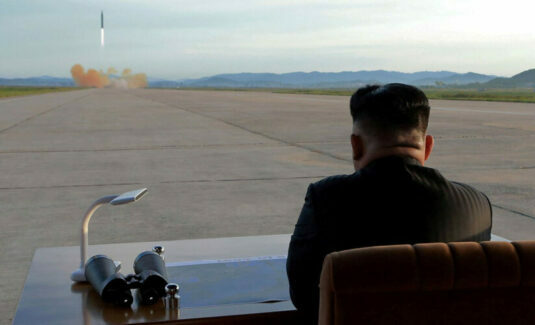
North Korea’s first ICBM test in years may trigger security crisis in the region | NK PRO North Korea conducted its most significant missile test in years on Thursday, marking an official end to Kim Jong Un’s April 2018 moratorium on long-range weapons testing. Besides representing the fin… North Korea’s first ICBM test in years may trigger security crisis in the region | NK PRO 1. While Kim Jong Un hinted he no longer felt bound by the self-declared testing moratorium on ICBMs and nuclear weapons, today’s launch is a clear sign that North Korea’s five-year pause on long-range weapons testing is now over. Renewed North Korean nuclear testing is therefore on the horizon and should surprise no one when it comes. But it remains to be seen whether this change to the status quo will influence a major change in U.S. policy towards North Korea. Given Washington has few options to compel Pyongyang to denuclearize and has its hands full in Ukraine, its unlikely the US will shift significantly away from positions outlined in Biden’s policy review last April. South Korea's position will harden, significantly, however. 2. Thursday’s ICBM reached an altitude of 6,200 km on a lofted trajectory and had a recorded range of some 1,080 km, indicating it may have been the massive Hwasong-17 first unveiled at the DPRK military parade in Oct. 2020. Though full standard trajectory launch estimations are not yet in, it’s probable that the test is part of Kim Jong Un’s Eighth Party Congress goal to develop an ICBM with a 15,000 km range. Today's launch also appears to be a success. Given North Korea only tested its Hwasong-15 ICBM once in 2017 before ordering it into mass production, this means Kim Jong Un could announce the new capability as complete, possibly as soon as tomorrow. 3. The ICBM launch comes amid Kim Jong Un’s recent order to: - expand and modernize the Sohae space launch facility - a forthcoming April 15 military parade - indicators that North Korea is the Punggye-ri nuclear test site. With U.S.-ROK military exercises scheduled to begin in April – a traditional friction point with Pyongyang – and a ROK presidential handover in May, the next weeks and months will offer numerous opportunities for Kim Jong Un to justify increasingly escalatory weapons testing. This is because, as a direct result of today’s launch, the U.S. and ROK will probably increase efforts to try to deter further North Korean escalation, by showcasing advanced military hardware ahead of and during forthcoming planned exercises. South Korean missile tests are already taking place, in retaliation to North Korea’s Thursday test, indicating that Seoul will likely also test its own emerging missile capabilities with increasing frequency in the short to medium term. Further, once Yoon Suk-yeol takes office, Seoul may engage in a more confrontational approach to North Korea that results in fiery rhetoric between the two sides and other non-military forms of confrontation, such as anti-regime broadcasts from loudspeakers along the border. If precedent is a guide, Pyongyang will use any such activities to raise tensions with South Korea, as well as to justify things like nuclear tests, submarine ballistic missile tests, and live-fire drills near the disputed inter-Korean maritime border. Conclusion: It seems inevitable that North Korea will soon return to nuclear testing, and with global focus on Ukraine, it’s unclear what consequences North Korea will face, at least from the perspective of new U.N. sanctions. But there can be no doubt: get ready for a bumpy ride on the peninsula in the weeks and months ahead. Tensions might not reach the fever pitch of 'fire and fury' in 2017, or the inter-Korean acrimony of 2013, but they will be close. • • • |
jward
passin' thru
[URL='https://twitter.com/vikasjournolko']

Vikas Tripathi
@vikasjournolko[/URL]
In response to #NorthKorea ICBM missile test, #SouthKorea tested missile from land, air and sea.
View: https://twitter.com/vikasjournolko/status/1506956433555968005?s=20&t=JzvOqhi-sd_omVxAM7B6Zg
Replying to
@vikasjournolko
#NorthKorea #SouthKorea
View: https://twitter.com/vikasjournolko/status/1506956701680996357?s=20&t=JzvOqhi-sd_omVxAM7B6Zg

Vikas Tripathi
@vikasjournolko[/URL]
In response to #NorthKorea ICBM missile test, #SouthKorea tested missile from land, air and sea.
View: https://twitter.com/vikasjournolko/status/1506956433555968005?s=20&t=JzvOqhi-sd_omVxAM7B6Zg
Replying to
@vikasjournolko
#NorthKorea #SouthKorea
View: https://twitter.com/vikasjournolko/status/1506956701680996357?s=20&t=JzvOqhi-sd_omVxAM7B6Zg
jward
passin' thru

Joseph Dempsey
@JosephHDempsey
1h
#NorthKorea suspected to have successfully conducted its first full lofted trajectory test of Hwasong-17 ICBM (Thread) https://en.yna.co.kr/view/AEN202203
(2nd LD) N. Korea fires apparent ICBM toward East Sea
Defense 17:42 March 24, 2022
(ATTN: UPDATES throughout with military's explanation)
By Song Sang-ho
SEOUL, March 24 (Yonhap) -- North Korea fired what seems to be a long-range missile toward the East Sea on Thursday, South Korea's military said.
Pyongyang's show of force, the 12th this year, effectively means an end to its self-imposed moratorium on nuclear and intercontinental ballistic missile (ICBM) testing.
The Joint Chiefs of Staff (JCS) said that it detected the launch from the Sunan airfield in Pyongyang at 2:34 p.m. and the missile flew some 1,080 kilometers at a top altitude of over 6,200 km.
The North appears to have launched the projectile at a lofted angle, the JCS said.
The Pyongyang airfield is where the North is presumed to have tested the Hwasong-17 ICBM on Feb. 27 and March 5.
Dubbed a "monster" missile for its size, the new ICBM is thought to carry multiple warheads and have a range exceeding 13,000 km.
The North's latest launch came four days after it fired four artillery shots into the Yellow Sea, apparently using multiple rocket launchers, from Sukchon, north of Pyongyang.
Last week, the North unsuccessfully fired an apparent long-range rocket system.
In January, Pyongyang made a veiled threat to lift its voluntary moratorium on strategic weapons tests that it declared in April 2018 amid nuclear diplomacy with Seoul and Washington.
A news report on North Korea's launch of a ballistic missile is aired on a television at Seoul Station on Feb. 27, 2022. (Yonhap)
sshluck@yna.co.kr
(END)
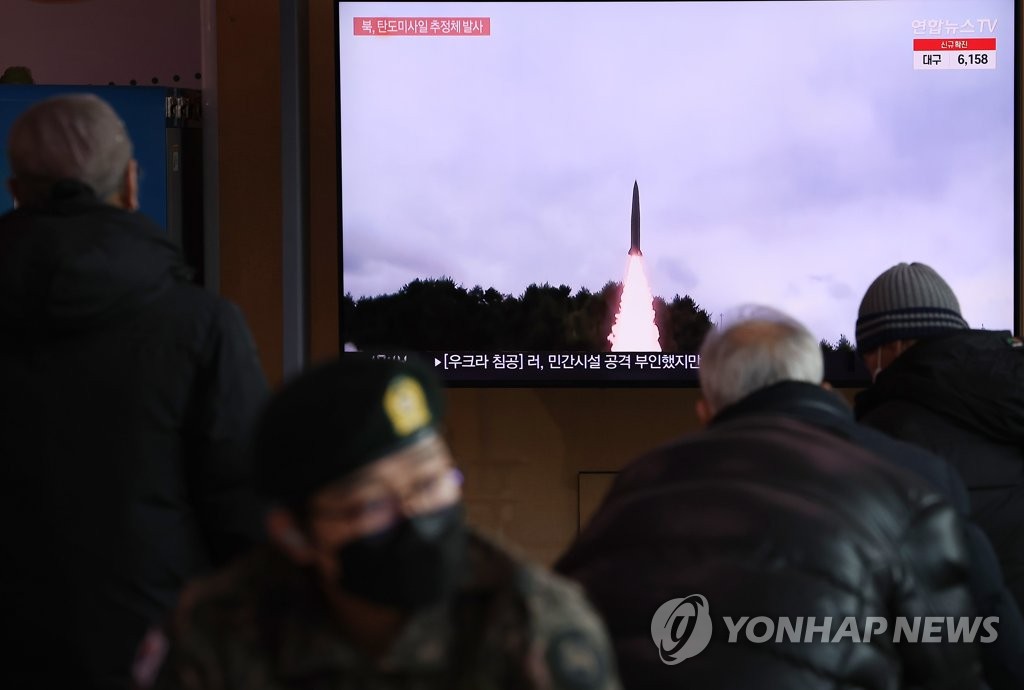
(2nd LD) N. Korea fires apparent ICBM toward East Sea | Yonhap News Agency
(ATTN: UPDATES throughout with military's explanation)By Song Sang-ho SEOUL, March ...
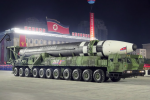
#Japan MoD estimates #NorthKorea missile flew for 71 minutes, covering a distance of about 1,100km with a max altitude exceeding 6000km https://mod.go.jp/j/press/news/2
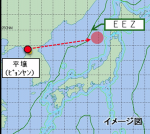

Joseph Dempsey
@JosephHDempsey

5:53 AM · Mar 24, 2022·Twitter Web App
Replying to
@JosephHDempsey
Flying so high to show they can send them in Space to blow UP western satellites.
onetimer
Veteran Member
North Korea’s new intercontinental ballistic missile flew 15x higher in space than orbit of International Space Station and 1,000 miles higher and almost 20 minutes longer than last ICBM test in 2017. Missile launch coincided with world leaders meeting at NATO headquarters today.
View: https://twitter.com/LucasFoxNews/status/1506962638898614280?t=wo7Dik-nLMCdc6NyABg_ag&s=19
View: https://twitter.com/LucasFoxNews/status/1506962638898614280?t=wo7Dik-nLMCdc6NyABg_ag&s=19
jward
passin' thru
Chinese foreign minister makes surprise stop in Afghanistan for talks with Taliban leaders
Published: 8:29pm, 24 Mar, 2022
Updated: 9:02pm, 24 Mar, 2022

China remains tight-lipped over what Amir Khan Muttaqi (left) and Wang Yi discussed in Kabul on Thursday. Photo: AFP
Chinese Foreign Minister Wang Yi made a surprise stop in Afghanistan on Thursday during his tour to shore up ties with the region.
Wang’s unannounced trip is China’s highest-level visit to the country since the Taliban took over in August following the retreat of the United States’ 20-year military operation. No country has formally recognised the Taliban government.
Wang’s visit was announced by Ahmad Yasir, a top Taliban government official, on Twitter on Thursday afternoon: “[The] Chinese Foreign Minister arrives in Kabul for talks with Islamic Emirate leaders.”
Wang was personally received by the Taliban’s acting foreign minister Amir Khan Muttaqi, according to the official state Bakhtar News Agency on Thursday afternoon.
A one-minute video posted by the agency reveals a meeting was held, with Wang and the Chinese delegation sitting on one side of a long table across from Muttaqi’s team.

Taliban acting foreign minister Amir Khan Muttaqi (centre right) meets China’s Foreign Minister Wang Yi (centre left) in Kabul on Thursday. Photo: AFP
Both Beijing and Kabul have remained tight-lipped about Wang’s visit to Afghanistan. Nor has his expected trip to India on Thursday and Friday been confirmed by India or China, who have been engaged in an ongoing border conflict.
Wang’s South Asia tour came as Beijing finds itself in a rapidly changing international environment, observing political and security restructuring in its neighbouring regions. Following Russia’s invasion of Ukraine in late February, Beijing has closely followed diplomatic reshuffling by South Korea’s newly elected President Yoon Suk-yeol and is keeping an eye on the return of full-scale military drills between the US and the Philippines next week.
China has presented itself as a party eager to solve and mediate the “Afghanistan problem” and Wang repeated in his meeting with Pakistani counterpart Shah Mahmood Qureshi this week that the Taliban government should be an inclusive one “sternly fighting against any forms of terrorism”.
While humanitarian agencies have been distributing aid to Afghanistan, Beijing has committed its own aid packages to the country, including food and coronavirus vaccines, as the United Nations warns of large-scale starvation among the 38.9 million population.
Beijing will host a meeting with foreign ministers representing Afghanistan’s neighbours – Turkmenistan, Uzbekistan, Tajikistan and Pakistan – this month to discuss humanitarian issues under Taliban rule, according to Pakistani officials.
During Wang’s stop in Pakistan, which represented China’s first attendance at the Organisation of Islamic Cooperation (OIC) foreign ministers’ conference, Wang attempted to build solidarity, saying China and Islamic countries were “developing countries” that had “shared goals for development”.
Afghan embassies are struggling to pay staff and bills, stay open
14 Mar 2022

He said China would support Islamic countries in “exploring a developing path suitable to their own needs” and would stand with the region to defend national integrity, territorial sovereignty and autonomy.
Lin Minwang, assistant dean at the Institute of International Studies at Fudan University, said the unannounced trip could mean China was “checking out” the situation in Afghanistan, but it was not likely to bestow official recognition until “higher-level officials” met.
“While the Chinese government has not officially recognised the Taliban government, there have been a lot of interactions in reality. China is also one of the countries that have contributed the most in humanitarian support and has been coordinating with other neighbouring countries in the region … this is so far their official stance towards the Taliban,” Lin said.
Despite diplomatic challenges in China’s neighbouring regions, Lin said China’s attempt to boost relations with Islamic countries in the region had been consistent.
“Afghanistan is also part of the Islamic world, despite it not being officially recognised yet,” Lin said.
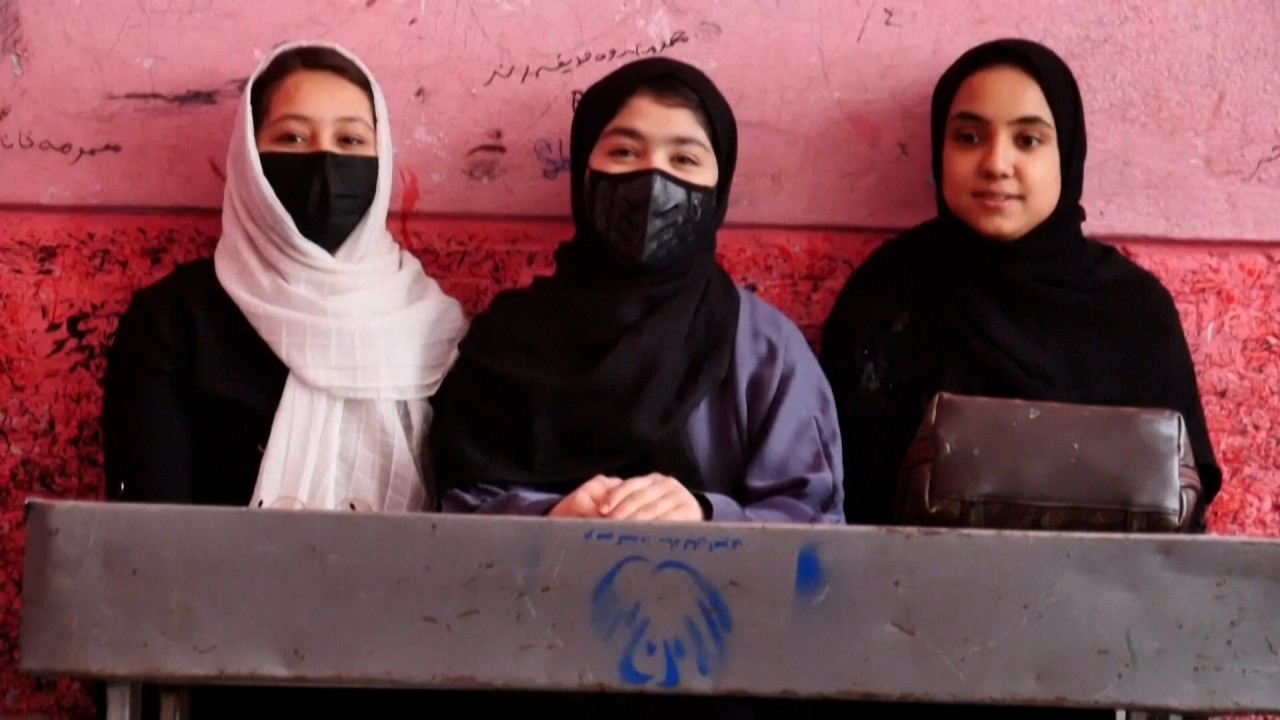
Heartbreak for Afghan schoolgirls as Taliban orders them back home hours after classrooms reopened
The Taliban has sought international recognition and for the lifting of Western sanctions that have further pressured the impoverished country. They have made commitments on human rights since taking over but have already been challenged by the UN and media reports on broken promises relating to crackdowns on civil society and girls’ education.
Pakistani Prime Minister Imran Khan was the first to visit Kabul last November, and so far has been the only head of state to do so. Britain’s special envoy for Famine Prevention and Humanitarian Affairs and envoy of the UK Mission to Afghanistan held talks with the Taliban last month.
China, which shares a border with Afghanistan, was one of the first countries to receive Taliban representatives in July, despite increasing violence in the country and before the insurgent group took control of the capital Kabul.

 www.scmp.com
www.scmp.com
- Wang Yi’s unannounced trip is China’s highest-level visit to the country since the Taliban took over in August
- Beijing will host a meeting of foreign ministers representing Afghanistan’s neighbours this month to discuss humanitarian issues under Taliban rule
Published: 8:29pm, 24 Mar, 2022
Updated: 9:02pm, 24 Mar, 2022

China remains tight-lipped over what Amir Khan Muttaqi (left) and Wang Yi discussed in Kabul on Thursday. Photo: AFP
Chinese Foreign Minister Wang Yi made a surprise stop in Afghanistan on Thursday during his tour to shore up ties with the region.
Wang’s unannounced trip is China’s highest-level visit to the country since the Taliban took over in August following the retreat of the United States’ 20-year military operation. No country has formally recognised the Taliban government.
Wang’s visit was announced by Ahmad Yasir, a top Taliban government official, on Twitter on Thursday afternoon: “[The] Chinese Foreign Minister arrives in Kabul for talks with Islamic Emirate leaders.”
Wang was personally received by the Taliban’s acting foreign minister Amir Khan Muttaqi, according to the official state Bakhtar News Agency on Thursday afternoon.
A one-minute video posted by the agency reveals a meeting was held, with Wang and the Chinese delegation sitting on one side of a long table across from Muttaqi’s team.

Taliban acting foreign minister Amir Khan Muttaqi (centre right) meets China’s Foreign Minister Wang Yi (centre left) in Kabul on Thursday. Photo: AFP
Both Beijing and Kabul have remained tight-lipped about Wang’s visit to Afghanistan. Nor has his expected trip to India on Thursday and Friday been confirmed by India or China, who have been engaged in an ongoing border conflict.
Wang’s South Asia tour came as Beijing finds itself in a rapidly changing international environment, observing political and security restructuring in its neighbouring regions. Following Russia’s invasion of Ukraine in late February, Beijing has closely followed diplomatic reshuffling by South Korea’s newly elected President Yoon Suk-yeol and is keeping an eye on the return of full-scale military drills between the US and the Philippines next week.
China has presented itself as a party eager to solve and mediate the “Afghanistan problem” and Wang repeated in his meeting with Pakistani counterpart Shah Mahmood Qureshi this week that the Taliban government should be an inclusive one “sternly fighting against any forms of terrorism”.
While humanitarian agencies have been distributing aid to Afghanistan, Beijing has committed its own aid packages to the country, including food and coronavirus vaccines, as the United Nations warns of large-scale starvation among the 38.9 million population.
Beijing will host a meeting with foreign ministers representing Afghanistan’s neighbours – Turkmenistan, Uzbekistan, Tajikistan and Pakistan – this month to discuss humanitarian issues under Taliban rule, according to Pakistani officials.
During Wang’s stop in Pakistan, which represented China’s first attendance at the Organisation of Islamic Cooperation (OIC) foreign ministers’ conference, Wang attempted to build solidarity, saying China and Islamic countries were “developing countries” that had “shared goals for development”.
Afghan embassies are struggling to pay staff and bills, stay open
14 Mar 2022

He said China would support Islamic countries in “exploring a developing path suitable to their own needs” and would stand with the region to defend national integrity, territorial sovereignty and autonomy.
Lin Minwang, assistant dean at the Institute of International Studies at Fudan University, said the unannounced trip could mean China was “checking out” the situation in Afghanistan, but it was not likely to bestow official recognition until “higher-level officials” met.
“While the Chinese government has not officially recognised the Taliban government, there have been a lot of interactions in reality. China is also one of the countries that have contributed the most in humanitarian support and has been coordinating with other neighbouring countries in the region … this is so far their official stance towards the Taliban,” Lin said.
Despite diplomatic challenges in China’s neighbouring regions, Lin said China’s attempt to boost relations with Islamic countries in the region had been consistent.
“Afghanistan is also part of the Islamic world, despite it not being officially recognised yet,” Lin said.

Heartbreak for Afghan schoolgirls as Taliban orders them back home hours after classrooms reopened
The Taliban has sought international recognition and for the lifting of Western sanctions that have further pressured the impoverished country. They have made commitments on human rights since taking over but have already been challenged by the UN and media reports on broken promises relating to crackdowns on civil society and girls’ education.
Pakistani Prime Minister Imran Khan was the first to visit Kabul last November, and so far has been the only head of state to do so. Britain’s special envoy for Famine Prevention and Humanitarian Affairs and envoy of the UK Mission to Afghanistan held talks with the Taliban last month.
China, which shares a border with Afghanistan, was one of the first countries to receive Taliban representatives in July, despite increasing violence in the country and before the insurgent group took control of the capital Kabul.

China’s foreign minister meets Taliban leaders in surprise Kabul stop
Wang Yi’s unannounced trip is China’s highest-level visit to Afghanistan since the Taliban took over in August.
jward
passin' thru
(News Focus) Concerns grow over possible North Korean nuke test
North Korea 20:42 March 24, 2022
SEOUL, March 24 (Yonhap) -- North Korea's firing of an intercontinental ballistic missile (ICBM) Thursday further raises the specter of its possible resumption of nuclear testing, observers say.
Responding quickly to Pyongyang's launch of the projectile into the East Sea, President Moon Jae-in accused the North's leader Kim Jong-un of breaking the promise of a self-imposed moratorium on ICBM testing.
Many regard it as a potential prelude to the recalcitrant Kim regime's push for another nuclear test, a "red line" drawn by South Korea and the United States.
Pyongyang has carried out six known nuclear tests since 2006, the last one in September 2017, at its Punggye-ri experiment site located in a mountainous northeastern region.
A file of North Korea's nuclear test site in Punggye-ri being dismantled in 2018. (Pool photo) (Yonhap)
The unpredictable North shut it down in 2018, blowing up some tunnels there, with a pledge to halt all nuclear tests, intended as a dialogue gesture towards Washington.
It even invited foreign journalists to witness the demolition. But the closure of the site has not been formally verified.
Of late, speculation has been rampant that the secretive nation could be working to repair the nuclear testing zone.
There is a view that the North may be able to bring it back to a state of readiness within the coming three to four months, at the earliest.
"All evidence points to the fact that North Korea has not abandoned the site and that the site is in caretaker status," Joseph Bermudez, senior fellow at the Center for Strategic and International Studies (CSIS) reportedly said, citing satellite photos of such activities as vehicle movements around the facilities.
Another possibility is that the North already has a new site for a nuclear test.
Furthermore, it seems to have reactivated the Yongbyon nuclear reactor, according to commercial satellite imagery.
A dilemma for Seoul and Washington is that they have no realistically effective means to stop Pyongyang from crossing the so-called red line.
lcd@yna.co.kr
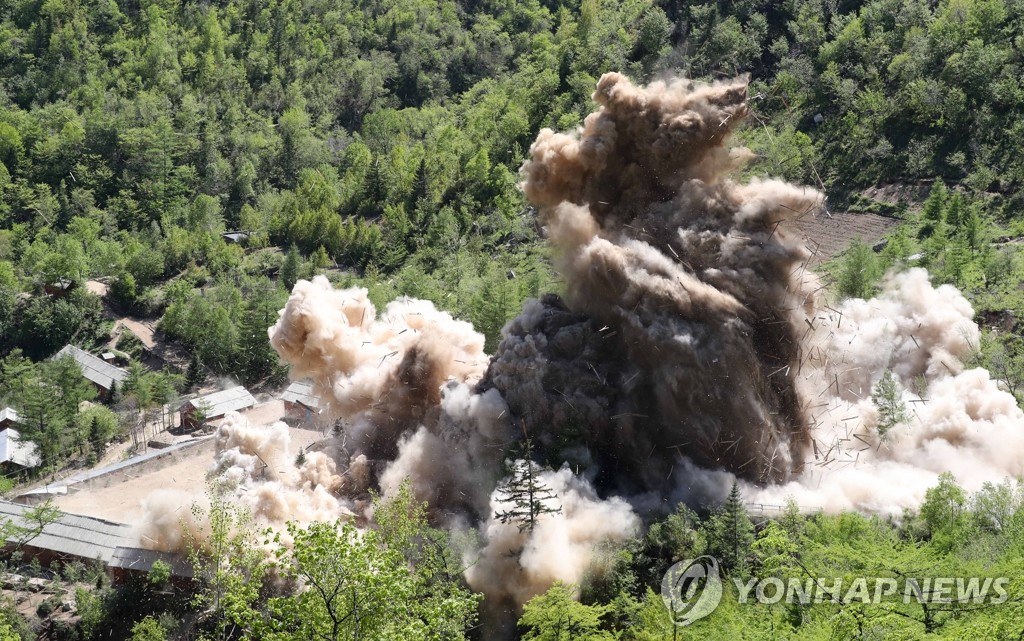
 en.yna.co.kr
en.yna.co.kr
North Korea 20:42 March 24, 2022
SEOUL, March 24 (Yonhap) -- North Korea's firing of an intercontinental ballistic missile (ICBM) Thursday further raises the specter of its possible resumption of nuclear testing, observers say.
Responding quickly to Pyongyang's launch of the projectile into the East Sea, President Moon Jae-in accused the North's leader Kim Jong-un of breaking the promise of a self-imposed moratorium on ICBM testing.
Many regard it as a potential prelude to the recalcitrant Kim regime's push for another nuclear test, a "red line" drawn by South Korea and the United States.
Pyongyang has carried out six known nuclear tests since 2006, the last one in September 2017, at its Punggye-ri experiment site located in a mountainous northeastern region.
A file of North Korea's nuclear test site in Punggye-ri being dismantled in 2018. (Pool photo) (Yonhap)
The unpredictable North shut it down in 2018, blowing up some tunnels there, with a pledge to halt all nuclear tests, intended as a dialogue gesture towards Washington.
It even invited foreign journalists to witness the demolition. But the closure of the site has not been formally verified.
Of late, speculation has been rampant that the secretive nation could be working to repair the nuclear testing zone.
There is a view that the North may be able to bring it back to a state of readiness within the coming three to four months, at the earliest.
"All evidence points to the fact that North Korea has not abandoned the site and that the site is in caretaker status," Joseph Bermudez, senior fellow at the Center for Strategic and International Studies (CSIS) reportedly said, citing satellite photos of such activities as vehicle movements around the facilities.
Another possibility is that the North already has a new site for a nuclear test.
Furthermore, it seems to have reactivated the Yongbyon nuclear reactor, according to commercial satellite imagery.
A dilemma for Seoul and Washington is that they have no realistically effective means to stop Pyongyang from crossing the so-called red line.
lcd@yna.co.kr

(News Focus) Concerns grow over possible North Korean nuke test | Yonhap News Agency
SEOUL, March 24 (Yonhap) -- North Korea's firing of an intercontinental ballistic mis...
jward
passin' thru
AnalysisMultimediaOngoing Projects
North Korean Missile Launches & Nuclear Tests: 1984-Present
April 20, 2017
Missile Defense Project






Updated March 24, 2022.
This database provides a chronology of North Korea missile launches and nuclear detonations, also reflected in the graphics above. These entries include full flight tests of ballistic and cruise missiles, both successful and unsuccessful, and nuclear tests. It does not include partial tests of missile subsystems such as static engine firings or cold-launch ejection system tests. It also does not show tests of air defense systems, or short-range rocket and artillery firings.


North Korean Missile Launches & Nuclear Tests: 1984-Present
April 20, 2017
Missile Defense Project
Updated March 24, 2022.
This database provides a chronology of North Korea missile launches and nuclear detonations, also reflected in the graphics above. These entries include full flight tests of ballistic and cruise missiles, both successful and unsuccessful, and nuclear tests. It does not include partial tests of missile subsystems such as static engine firings or cold-launch ejection system tests. It also does not show tests of air defense systems, or short-range rocket and artillery firings.


jward
passin' thru
| Date | Missile Type | Number Launched/Yield | More info |
| Mar-24-2022 | Unidentified ICBM | 1 | New York Times |
| Mar-16-2022 | Failed ICBM Development Test | 1 | Washington Post |
| Mar-4-2022 | ICBM Development Test | 1 | New York Times |
| Feb-27-2022 | ICBM Development Test | 1 | Reuters |
| Jan-30-2022 | Hwasong-12 (IRBM) | 1 | Japan Times |
| Jan-25-2022 | Cruise Missile | 2 | Wall Street Journal |
| Jan-17-2022 | KN-24 (SRBM) | 2 | VOA |
| Jan-13-2022 | KN-23 (SRBM) | 2 | New York Times |
| Jan-11-2022 | MaRV Ballistic Missile | 1 | VOA |
| Jan-4-2022 | MaRV Ballistic Missile | 1 | NBC News |
| Oct-19-2021 | “New type SLBM” | 1 | The Washington Post |
| Sep-29-2021 | New “hypersonic” weapon | 1 | Yonhap News |
| Sep-16-2021 | KN-23 (SRBM) | 2 | Reuters |
| Sep-13-2021 | New long-range cruise missile | 2 | Yonhap News |
| Mar-25-2021 | New SRBM | 2 | Associated Press |
| Mar-21-2021 | Unknown (Cruise Missile) | 2 | The Diplomat |
| Jul-6-2020 | Unknown (ASCM) | 1 | Yonhap News |
| Apr-14-2020 | Kumsong-3 (ASCM) | 2+ | Yonhap News |
| Mar-29-2020 | KN-25 (SRBM) | 2 | Yonhap News |
| Mar-21-2020 | KN-24 (SRBM) | 2 | Yonhap News |
| Mar-2-2020 | KN-25 (SRBM) | 2 | Yonhap News |
| Nov-28-2019 | KN-25 (SRBM) | 2 | Missile Threat |
| Oct-31-2019 | KN-25 (SRBM) | 2 | Yonhap News |
| Oct-2-2019 | Pukguksong-3 (SLBM) | 1 | The Japan Times |
| Sep-9-2019 | KN-25 (SRBM) | 2 | Yonhap News |
| Aug-24-2019 | KN-25 (SRBM) | 2 | Yonhap News |
| Aug-16-2019 | KN-24 (SRBM) | 2 | Yonhap News |
| Aug-10-2019 | KN-24 (SRBM) | 2 | Yonhap News |
| Aug-6-2019 | KN-23 (SRBM) | 2 | Yonhap News |
| Jul-25-2019 | KN-23 (SRBM) | 2 | Yonhap News |
| May-9-2019 | KN-23 (SRBM) | 2 | New York Times |
| May-4-2019 | KN-23 (SRBM) | 1 | Washington Post |
| Nov-28-2017 | Hwasong-15 (ICBM) | 1 | CNN |
| Sep-14-2017 | Hwasong-12 (IRBM) | 1 | Associated Press |
| Sep-3-2017 | Nuclear Test | 100-140 kt yield | Newsweek |
| Aug-28-2017 | Hwasong-12 (IRBM) | 1 | Washington Post |
| Aug-26-2017 | KN-21 Scud variant (SRBM) | 3 | Washington Post |
| Jul-28-2017 | Hwasong-14 (ICBM) | 1 | Washington Post |
| Jul-4-2017 | Hwasong-14 (ICBM) | 1 | CNN |
| Jun-7-2017 | Kumsong-3 (ASCM) | 4 | Reuters |
| May-28-2017 | KN-18 (SRBM) | 1 | Reuters |
| May-21-2017 | KN-15 (MRBM) | 1 | CBS |
| May-14-2017 | Hwasong-12 (IRBM) | 1 | CBS |
| Apr-29-2017 | Hwasong-12 (IRBM) | 1 | Reuters |
| Apr-16-2017 | Hwasong-12 (IRBM) | 1 | Fox News |
| Apr-5-2017 | Hwasong-12 (IRBM) | 1 | Fox News |
| Mar-22-2017 | Unknown | 1 | North Korea News |
| Mar-6-2017 | Scud-ER (MRBM) | 4 | New York Times |
| Feb-12-2017 | KN-15 (Pukkuksong-2) | 1 | CNN |
| Oct-19-2016 | Musudan | 1 | New York Times |
| Oct-15-2016 | Musudan | 1 | New York Times |
| Sep-9-2016 | Nuclear Test | 10 kt yield | BBC |
| Sep-5-2016 | No Dong | 3 | CNN |
| Aug-24-2016 | KN-11 (SLBM) | 1 | BBC |
| Aug-3-2016 | No Dong | 1 | New York Times |
| Jul-18-2016 | SRBM (Scud variant) | 3 | CNN |
| Jul-9-2016 | KN-11 (SLBM) | 1 | Reuters |
| Jun-22-2016 | Musudan | 2 | CNN |
| May-31-2016 | Musudan | 1 | BBC |
| Apr-28-2016 | Musudan | 2 | Reuters |
| Apr-23-2016 | KN-11 (SLBM) | 1 | North Korea |
| Apr-15-2016 | Musudan | 1 | BBC |
| Mar-9-2016 | SRBM (Scud variant) | 2 | New York Times |
| Feb-7-2016 | Taepodong-2 / Unha-3 / | 1 | BBC |
| Jan-6-2016 | Nuclear Test | 7-10 kt yield | Federation of American Scientists |
jward
passin' thru
| Dec-21-2015 | KN-11 (SLBM) | 1 | Yonhap News |
| Nov-28-2015 | KN-11 (SLBM) | 1 | Reuters |
| Jun-14-2015 | KN-01 (Cruise Missile) | 3 | CNN |
| May-9-2015 | KN-11 (SLBM) | 1 | CNN |
| Apr-3-2015 | KN-02 (SRBM) | 4 | UPI |
| Mar-2-2015 | SRBM (Scud variant) | 2 | New York Times |
| Feb-8-2015 | KN-02 (SRBM) | 5 | New York Times |
| Feb-7-2015 | Kumsong-3 (Cruise Missile) | 1 | New York Times |
| Sep-6-2014 | KN-02 (SRBM) | 3 | New York Times |
| Sep-1-2014 | KN-02 (SRBM) | 1 | Telegraph |
| Jul-26-2014 | SRBM (Scud variant) | 1 | Washington Times |
| Jul-13-2014 | SRBM (Scud variant) | 2 | USA Today |
| Jul-9-2014 | SRBM (Scud variant) | 2 | New York Times |
| Mar-25-2014 | No Dong | 2 | BBC |
| Mar-3-2014 | SRBM (Scud variant) | 2 | CNN |
| Feb-27-2014 | SRBM (Scud variant) | 4 | Reuters |
| Feb-12-2013 | Nuclear Test | 6-9 kt yield | New York Times |
| May-(19/20)-2013 | SRBM | 3 | Reuters |
| May-18-2013 | SRBM | 3 | New York Times |
| Mar-2013 | KN-02 (SRBM) | 2 | Korea Times |
| Dec-12-2012 | Taepodong-2 / Unha-3 / | 1 | New York Times |
| Apr-2012 | Taepodong-2 / Unha-3 / | 1 | IHS Jane’s Weapons: Strategic, 2015-2016 |
| Jan-11-2012 | KN-02 (SRBM) | 2 | IHS Jane’s Weapons: Strategic, 2015-2016 |
| Oct-12-2009 | KN-02 (SRBM) | 5 | CBS News |
| Jul-2009 | Scud-ER (MRBM) | 4 | IHS Jane’s Weapons: Strategic, 2015-2016 |
| July-2009 | No Dong 2 | 2 | IHS Jane’s Weapons: Strategic, 2015-2016 |
| May-25-2009 | Nuclear Test | 2.4 kt yield | New York Times |
| May-25-2009 | KN-02 (SRBM) | 3 | New York Times |
| Apr-5-2009 | Taepodong-2 / Unha-3 / | 1 | IHS Jane’s Weapons: Strategic, 2015-2016 |
| May-2008 | KN-01 (Cruise Missile) | 3 | IHS Jane’s Weapons: Strategic, 2015-2016 |
| Mar-2008 | KN-01 (Cruise Missile) | 3 | IHS Jane’s Weapons: Strategic, 2015-2016 |
| Jun-2007 | KN-02 (SRBM) | 3 | IHS Jane’s Weapons: Strategic, 2015-2016 |
| Jun-19-2007 | KN-01 (Cruise Missile) | 1 | UPI |
| Jun-7-2007 | KN-01 (Cruise Missile) | 2 | NTI |
| May-25-2007 | KN-01 (Cruise Missile) | 1 | NTI |
| Oct-09-2006 | Nuclear Test | 1-2 kt yield | Nautilus Institute |
| Jul-05-2006 | No Dong | 2 | White House |
| Jul-05-2006 | SRBM (Scud variant) | 4 | White House |
| Jul-05-2006 | Taepodong 2 | 1 | IHS Jane’s Weapons: Strategic, 2015-2016 |
| Mar-08-2006 | KN-02 (SRBM) | 2 | NTI |
| May-2005 | KN-02 (SRBM) | 2 | IHS Jane’s Weapons: Strategic, 2015-2016 |
| Apr-2004 | KN-02 (SRBM) | 1 | IHS Jane’s Weapons: Strategic, 2015-2016 |
| Mar-1-2003 | KN-01 (Cruise Missile) | 1 | Armscontrol.org |
| Oct-2003 | KN-01 (Cruise Missile) | 2 | DTIC |
| Aug-31-1998 | Taepodong-1 | 1 | IHS Jane’s Weapons: Strategic, 2015-2016 |
| May-31-1994 | KN-01 (Cruise Missile) | 1 | Middlebury Institute of International Studies at Monterey |
| May-1993 | No Dong 1 | 2 | New York Times |
| May-1993 | Hwasong 6 (SRBM) | 2 | New York Times |
| Jun-1992 | No Dong 1 | 1 | IHS Jane’s Weapons: Strategic, 2015-2016 |
| Oct-1991 | Hwasong 6 (SRBM) | 1 | IHS Jane’s Weapons: Strategic, 2015-2016 |
| Aug-1991 | No Dong 1 | 1 | IHS Jane’s Weapons: Strategic, 2015-2016 |
| Jun-1990 | Hwasong 6 (SRBM) | 1 | IHS Jane’s Weapons: Strategic, 2015-2016 |
| May-1990 | No Dong 1 | 1 | IHS Jane’s Weapons: Strategic, 2015-2016 |
| Apr-1984 | Hwasong 5 (SRBM) | 7 | IHS Jane’s Weapons: Strategic, 2015-2016 |
Missile Defense Project
jward
passin' thru
North Korea Tests ICBM
March 24, 2022
Masao Dahlgren
On March 24, North Korea flight tested an intercontinental ballistic missile (ICBM) from a site off its east coast. South Korean authorities announced that the missile, reported elsewhere as the Hwasong-17, reached a maximum altitude of 6,200 km and a range of 1,080 km from its launch site, while Japanese officials stated that the “new type” of ICBM flew 71 minutes, reaching a maximum altitude of 6,000 km and a range of 1,100 km. This represents the longest such test for a North Korean ICBM. The last full-range ICBM launch took place in November 2017.
Related Links:
N.Korea tests largest ICBM, White House condemns return to long-range launches, Reuters
Seoul, Washington react sternly to provocative North Korean ICBM firing, Yonhap News






Masao Dahlgren is a research associate with the CSIS Missile Defense Project, where he focuses on deterrence and emerging technologies.
Cite this Page
Masao Dahlgren, "North Korea Tests ICBM," Missile Threat, Center for St
CSIS Missile Defense
@Missile_Defense
The ICBM that North Korea launched today flew higher, further, and longer than any of its previous ICBM test flights. https://missilethreat.csis.org/north-korea-te
View: https://twitter.com/Missile_Defense/status/1507064541221474315?s=20&t=M5_UdOqzIGD0hyfbKHaWTw
March 24, 2022
Masao Dahlgren
On March 24, North Korea flight tested an intercontinental ballistic missile (ICBM) from a site off its east coast. South Korean authorities announced that the missile, reported elsewhere as the Hwasong-17, reached a maximum altitude of 6,200 km and a range of 1,080 km from its launch site, while Japanese officials stated that the “new type” of ICBM flew 71 minutes, reaching a maximum altitude of 6,000 km and a range of 1,100 km. This represents the longest such test for a North Korean ICBM. The last full-range ICBM launch took place in November 2017.
Related Links:
N.Korea tests largest ICBM, White House condemns return to long-range launches, Reuters
Seoul, Washington react sternly to provocative North Korean ICBM firing, Yonhap News
Masao Dahlgren is a research associate with the CSIS Missile Defense Project, where he focuses on deterrence and emerging technologies.
Cite this Page
Masao Dahlgren, "North Korea Tests ICBM," Missile Threat, Center for St
CSIS Missile Defense
@Missile_Defense
The ICBM that North Korea launched today flew higher, further, and longer than any of its previous ICBM test flights. https://missilethreat.csis.org/north-korea-te
View: https://twitter.com/Missile_Defense/status/1507064541221474315?s=20&t=M5_UdOqzIGD0hyfbKHaWTw
onetimer
Veteran Member
InsideNK@inside_nk
North Korea leader Kim Jong-un says North Korea will prepare for a long-term confrontation with the U.S. (Yonhap)
2:51 PM · Mar 24, 2022
North Korea leader Kim Jong-un says North Korea will prepare for a long-term confrontation with the U.S. (Yonhap)
2:51 PM · Mar 24, 2022
jward
passin' thru
[URL='https://twitter.com/nktpnd']

Ankit Panda
@nktpnd[/URL]
Largest liquid propellant missile ever launched from a road-mobile launcher. Ever. Anywhere.
Ankit Panda
@nktpnd
2h
NEW: First images of North Korea's Hwasongpho-17 ICBM.
View: https://twitter.com/nktpnd/status/1507103483861864457?s=20&t=M5_UdOqzIGD0hyfbKHaWTw
Cool guys don't look at their ICBMs.
View: https://twitter.com/nktpnd/status/1507103781602963457?s=20&t=M5_UdOqzIGD0hyfbKHaWTw
More. Nice new payload fairing livery.
View: https://twitter.com/nktpnd/status/1507103889866301447?s=20&t=M5_UdOqzIGD0hyfbKHaWTw
160 ton force first stage. That'll get you to 6,200 km, yeah.
View: https://twitter.com/nktpnd/status/1507104672573763593?s=20&t=M5_UdOqzIGD0hyfbKHaWTw

Ankit Panda
@nktpnd[/URL]
Largest liquid propellant missile ever launched from a road-mobile launcher. Ever. Anywhere.
Ankit Panda
@nktpnd
2h
NEW: First images of North Korea's Hwasongpho-17 ICBM.
View: https://twitter.com/nktpnd/status/1507103483861864457?s=20&t=M5_UdOqzIGD0hyfbKHaWTw
Cool guys don't look at their ICBMs.
View: https://twitter.com/nktpnd/status/1507103781602963457?s=20&t=M5_UdOqzIGD0hyfbKHaWTw
More. Nice new payload fairing livery.
View: https://twitter.com/nktpnd/status/1507103889866301447?s=20&t=M5_UdOqzIGD0hyfbKHaWTw
160 ton force first stage. That'll get you to 6,200 km, yeah.
View: https://twitter.com/nktpnd/status/1507104672573763593?s=20&t=M5_UdOqzIGD0hyfbKHaWTw
Show572
Stop the world, I want to get off.
What the hell is he smoking?InsideNK@inside_nk
North Korea leader Kim Jong-un says North Korea will prepare for a long-term confrontation with the U.S. (Yonhap)
2:51 PM · Mar 24, 2022
Cohibas with "something special".....What the hell is he smoking?
[URL='https://twitter.com/nktpnd']

Ankit Panda
@nktpnd[/URL]
Largest liquid propellant missile ever launched from a road-mobile launcher. Ever. Anywhere.
Ankit Panda
@nktpnd
2h
NEW: First images of North Korea's Hwasongpho-17 ICBM.
View: https://twitter.com/nktpnd/status/1507103483861864457?s=20&t=M5_UdOqzIGD0hyfbKHaWTw
Cool guys don't look at their ICBMs.
View: https://twitter.com/nktpnd/status/1507103781602963457?s=20&t=M5_UdOqzIGD0hyfbKHaWTw
More. Nice new payload fairing livery.
View: https://twitter.com/nktpnd/status/1507103889866301447?s=20&t=M5_UdOqzIGD0hyfbKHaWTw
160 ton force first stage. That'll get you to 6,200 km, yeah.
View: https://twitter.com/nktpnd/status/1507104672573763593?s=20&t=M5_UdOqzIGD0hyfbKHaWTw
That thing's a beast!.....
jward
passin' thru
Gotta give mad props n much <3 to magnificent beasts
..even when ya know it's amazin' power can be misdirected toward friends instead o' the enemy..
..even when ya know it's amazin' power can be misdirected toward friends instead o' the enemy..
That thing's a beast!.....
jward
passin' thru
Ankit Panda
@nktpnd
4m
I spoke to @joshjonsmith about the strategic rationale for North Korea's new large ICBM:
Analysis: With largest test yet, North Korea's ICBM programme hits new heights
By Josh Smith
North Korea reported its latest launch was the Hwasong-17, a huge new intercontinental ballistic missile (ICBM), fired on Thursday in a test that leader Kim Jong Un said was designed to demonstrate the might of its nuclear force and deter any U.S. military moves. read more
It was the first full-scale ICBM test launch since 2017. There were two launches in February and March that U.S. officials said were preliminary tests of the Hwasong-17. read more
Some analysts said that discrepancies in imagery released by North Korea suggested that it may be hiding details about the launch, and South Korean media have reported that officials are examining whether the missile was in fact a Hwasong-17.
With a range that the Japanese government said probably exceeds 15,000 km (9,320 miles), the missile fired on Thursday could strike targets anywhere in the world outside of a few countries in South America and parts of Antarctica.
That range, and its massive size, suggest North Korea plans to tip it with multiple warheads that could hit several targets or deploy decoys to confuse defenders, analysts say. North Korea's smaller Hwasong-15 ICBM, tested in 2017, can reach any part of the United States, but cannot carry as large a payload.
"Since there aren't any good targets farther away, this missile is likely about carrying more weight — in the form of multiple nuclear warheads," said Melissa Hanham, a researcher at Stanford University's Center for International Security and Cooperation (CISAC) in California. "This makes U.S. ballistic missile defence even more difficult to achieve."
Along with other new weapons such as hypersonic missiles, smaller nuclear warheads and drones, North Korean leader Kim has made deployment of a 15,000 km-range ICBM with multiple warheads a goal.
"The offensive arithmetic will be in their favour soon; they may be able to keep up with advances in American defences," said Ankit Panda, a senior fellow at the U.S.-based Carnegie Endowment for International Peace.
U.S. officials have predicted such advancements, and last year selected Lockheed Martin and Northrop Grumman to compete to build a Next Generation Interceptor (NGI) designed to shoot down missiles from "rogue nations" such as North Korea and Iran, said Thomas Karako, the director of the Missile Defense Project at the Center for Strategic and International Studies (CSIS).
"This (new missile) gives North Korea more options," he said, noting that the longer range could also allow it to be fired at the United States using more indirect flight paths, potentially confusing defenders.
South Korean president-elect Yoon Suk-yeol has vowed to boost missile defences to counter North Korean weapons, and has suggested that developing a preemptive strike capability may be the only way to prevent a missile attack.
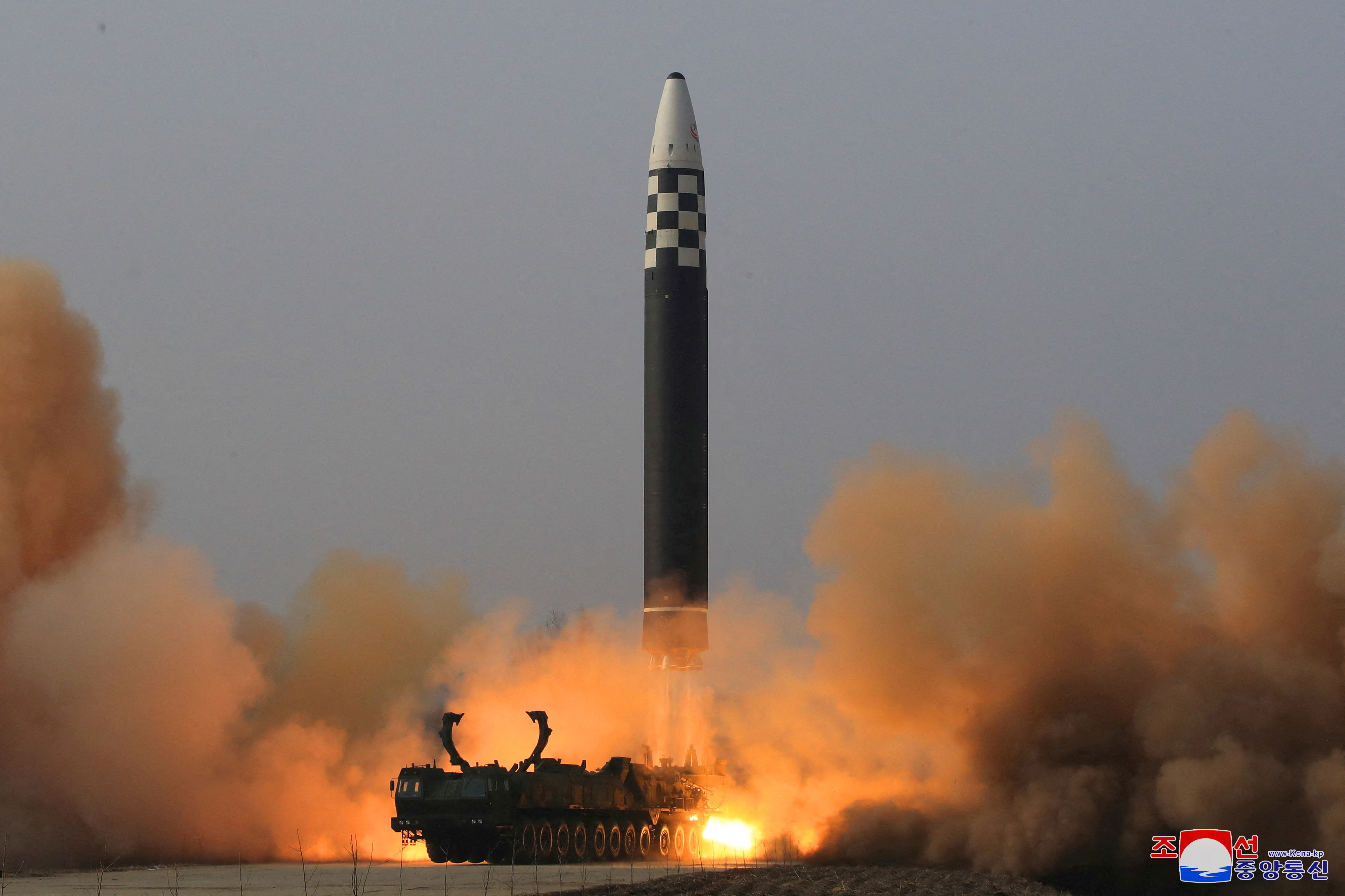
General view during the test firing of what state media report is a North Korean "new type" of intercontinental ballistic missile (ICBM) in this undated photo released on March 24, 2022 by North Korea's Korean Central News Agency (KCNA). KCNA via REUTERS/File Photo
'CREDIBLE DETERRENCE'
The "lofted" tests North Korea has conducted, which send missiles high into space rather than far away, help confirm some elements of the system, such as full engine burns and staging. But other elements, such as accuracy and the survivability of the reentry vehicles that would carry a nuclear warhead, remain less verifiable in such tests, said Joseph Dempsey, a defence researcher at the International Institute for Strategic Studies.
"Typically there would be dozens of partial and full flight tests through a full spectrum of operational parameters before a system is accepted and mass produced for service," he said, noting that North Korea faces diplomatic and geographical constraints on long-range tests. "However, even limited successful tests can still provide enough minimal credible deterrence value."
For instance, lofted tests expose reentry vehicles to much more heat and stress than a normal attack trajectory, meaning they might not survive or perform as designed. North Korea said it fired Thursday's missile "in a vertical launch mode" to ensure the safety of neighbouring countries.
Rachel Minyoung Lee, with the Washington-based 38 North programme that monitors North Korea, said Pyongyang's goal seems to be to strengthen its leverage so it can turn denuclearization talks into nuclear-reduction talks.
"The message of the North Korean readout of yesterday’s ICBM launch is clear: North Korea will continue to develop its nuclear arsenal," she said.
A MISSILE THAT'S TOO BIG?
The Hwasong-17 had already been unveiled at military parades and defence expos, giving experts a good idea of what to expect.
Thursday's launch showed for the first time, however, that the Hwasong-17 was launched directly from its massive transporter, erector, launcher (TEL) vehicle, which has 11 axles.
Previous North Korean ICBMs were transported and raised by such vehicles, but then usually fired from detachable platforms. TELs make it easer to conceal missiles until they are deployed for use, but Panda said the Hwasong-17 is so large there could be serious concerns about its operational practicality.
"There's a reason that no other country has ever decided to deploy a liquid-fuelled missile that’s this big on a road-mobile launcher: it’s unsafe and operationally unwieldy," Panda said, while noting North Korea seems to accept the risk. "A silo, which might make more sense for a missile this size, would be strategically worse for the North Koreans given its vulnerability to prompt preemption."
The next step for North Korea would be building solid-fuel missiles, which are more stable and can be launched with almost no warning or preparation time.
/cloudfront-us-east-2.images.arcpublishing.com/reuters/HVJA62UD5JM2PCUAYKHU4K6IHU.jpg)
 www.reuters.com
www.reuters.com
@nktpnd
4m
I spoke to @joshjonsmith about the strategic rationale for North Korea's new large ICBM:
Analysis: With largest test yet, North Korea's ICBM programme hits new heights
By Josh Smith
- First full-scale ICBM test since 2017
- Massive rocket puts most of the world in range
- Tests expand capabilities, boost reliability - analysts
- N.Korea leader says new missile strengthens nuclear deterrence
North Korea reported its latest launch was the Hwasong-17, a huge new intercontinental ballistic missile (ICBM), fired on Thursday in a test that leader Kim Jong Un said was designed to demonstrate the might of its nuclear force and deter any U.S. military moves. read more
It was the first full-scale ICBM test launch since 2017. There were two launches in February and March that U.S. officials said were preliminary tests of the Hwasong-17. read more
Some analysts said that discrepancies in imagery released by North Korea suggested that it may be hiding details about the launch, and South Korean media have reported that officials are examining whether the missile was in fact a Hwasong-17.
With a range that the Japanese government said probably exceeds 15,000 km (9,320 miles), the missile fired on Thursday could strike targets anywhere in the world outside of a few countries in South America and parts of Antarctica.
That range, and its massive size, suggest North Korea plans to tip it with multiple warheads that could hit several targets or deploy decoys to confuse defenders, analysts say. North Korea's smaller Hwasong-15 ICBM, tested in 2017, can reach any part of the United States, but cannot carry as large a payload.
"Since there aren't any good targets farther away, this missile is likely about carrying more weight — in the form of multiple nuclear warheads," said Melissa Hanham, a researcher at Stanford University's Center for International Security and Cooperation (CISAC) in California. "This makes U.S. ballistic missile defence even more difficult to achieve."
Along with other new weapons such as hypersonic missiles, smaller nuclear warheads and drones, North Korean leader Kim has made deployment of a 15,000 km-range ICBM with multiple warheads a goal.
"The offensive arithmetic will be in their favour soon; they may be able to keep up with advances in American defences," said Ankit Panda, a senior fellow at the U.S.-based Carnegie Endowment for International Peace.
U.S. officials have predicted such advancements, and last year selected Lockheed Martin and Northrop Grumman to compete to build a Next Generation Interceptor (NGI) designed to shoot down missiles from "rogue nations" such as North Korea and Iran, said Thomas Karako, the director of the Missile Defense Project at the Center for Strategic and International Studies (CSIS).
"This (new missile) gives North Korea more options," he said, noting that the longer range could also allow it to be fired at the United States using more indirect flight paths, potentially confusing defenders.
South Korean president-elect Yoon Suk-yeol has vowed to boost missile defences to counter North Korean weapons, and has suggested that developing a preemptive strike capability may be the only way to prevent a missile attack.

General view during the test firing of what state media report is a North Korean "new type" of intercontinental ballistic missile (ICBM) in this undated photo released on March 24, 2022 by North Korea's Korean Central News Agency (KCNA). KCNA via REUTERS/File Photo
'CREDIBLE DETERRENCE'
The "lofted" tests North Korea has conducted, which send missiles high into space rather than far away, help confirm some elements of the system, such as full engine burns and staging. But other elements, such as accuracy and the survivability of the reentry vehicles that would carry a nuclear warhead, remain less verifiable in such tests, said Joseph Dempsey, a defence researcher at the International Institute for Strategic Studies.
"Typically there would be dozens of partial and full flight tests through a full spectrum of operational parameters before a system is accepted and mass produced for service," he said, noting that North Korea faces diplomatic and geographical constraints on long-range tests. "However, even limited successful tests can still provide enough minimal credible deterrence value."
For instance, lofted tests expose reentry vehicles to much more heat and stress than a normal attack trajectory, meaning they might not survive or perform as designed. North Korea said it fired Thursday's missile "in a vertical launch mode" to ensure the safety of neighbouring countries.
Rachel Minyoung Lee, with the Washington-based 38 North programme that monitors North Korea, said Pyongyang's goal seems to be to strengthen its leverage so it can turn denuclearization talks into nuclear-reduction talks.
"The message of the North Korean readout of yesterday’s ICBM launch is clear: North Korea will continue to develop its nuclear arsenal," she said.
A MISSILE THAT'S TOO BIG?
The Hwasong-17 had already been unveiled at military parades and defence expos, giving experts a good idea of what to expect.
Thursday's launch showed for the first time, however, that the Hwasong-17 was launched directly from its massive transporter, erector, launcher (TEL) vehicle, which has 11 axles.
Previous North Korean ICBMs were transported and raised by such vehicles, but then usually fired from detachable platforms. TELs make it easer to conceal missiles until they are deployed for use, but Panda said the Hwasong-17 is so large there could be serious concerns about its operational practicality.
"There's a reason that no other country has ever decided to deploy a liquid-fuelled missile that’s this big on a road-mobile launcher: it’s unsafe and operationally unwieldy," Panda said, while noting North Korea seems to accept the risk. "A silo, which might make more sense for a missile this size, would be strategically worse for the North Koreans given its vulnerability to prompt preemption."
The next step for North Korea would be building solid-fuel missiles, which are more stable and can be launched with almost no warning or preparation time.
/cloudfront-us-east-2.images.arcpublishing.com/reuters/HVJA62UD5JM2PCUAYKHU4K6IHU.jpg)
Analysis: With largest test yet, North Korea's ICBM programme hits new heights
North Korea's resumption of long-range missile tests, including a flight of its largest-ever weapon, puts it closer than ever to having a reliable way of delivering multiple nuclear warheads anywhere in the United States, analysts say.
jward
passin' thru
:: shrug :: guess intrigue is too tempting, they can't just #tell it like it is
Ankit Panda
@nktpnd
1h
Really good catch here.
Wouldn't need this even. (Japan fishing it out of ocean) US space-based infrared sensors should have been able to discriminate the plume of a 160 tf first stage booster from a 80 tf first stage booster above cloud break (if not in real-time, then in subsequent analysis).
Ankit Panda
@nktpnd
1h
Really good catch here.
Colin considers alternative hypotheses, but recall the reports yesterday before KCNA released suggesting ROK intelligence was leaning Hwasong-15 on this launch. In general, strategic deception hasn’t been the norm with ground-launched missiles (more with the sub program).Lots of KCTV footage of the Hwasong-17 ICBM test doesn't match up with satellite imagery of the launch site Possible scenario: it's Hwasong-17 footage up until it exploded on March 16, using Hwasong-15 flight data March 24 as cover
It would mean whatever they successfully tested March 24 is being covered up and hidden, maybe forever, even though it was their greatest missile achievement ever. Or they launched another Hwasong-17 on March 24 but their cameras failed so they used old footage..
But what happens if Japan fishes out some missile debris and it's identified as a Hwasong-15 or something? I guess we'll see
Colin Zwirko
@ColinZwirko
View: https://twitter.com/ColinZwirko/status/1507296302157406213?s=20&t=7vzxG-WHLmp3R3DQ8XXm9w
Wouldn't need this even. (Japan fishing it out of ocean) US space-based infrared sensors should have been able to discriminate the plume of a 160 tf first stage booster from a 80 tf first stage booster above cloud break (if not in real-time, then in subsequent analysis).

